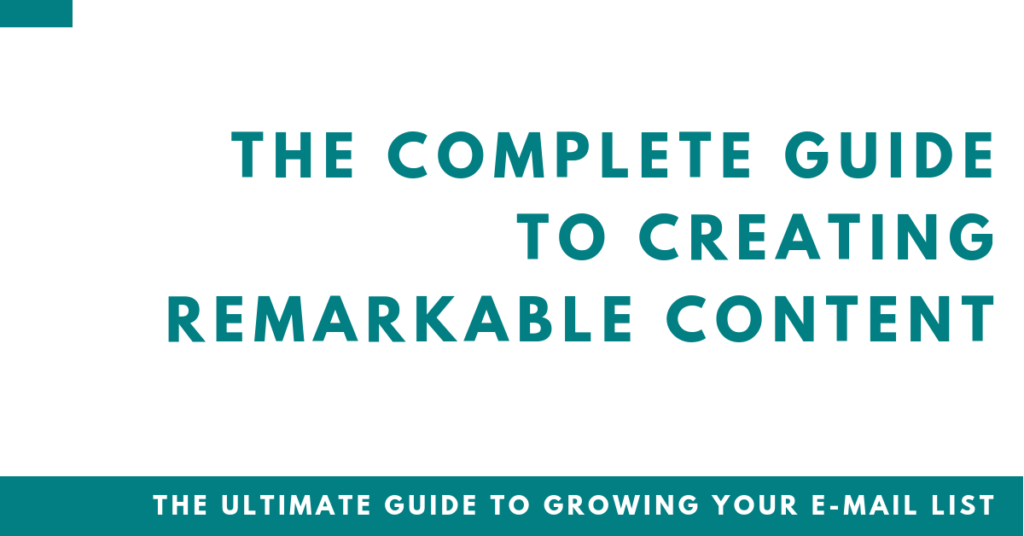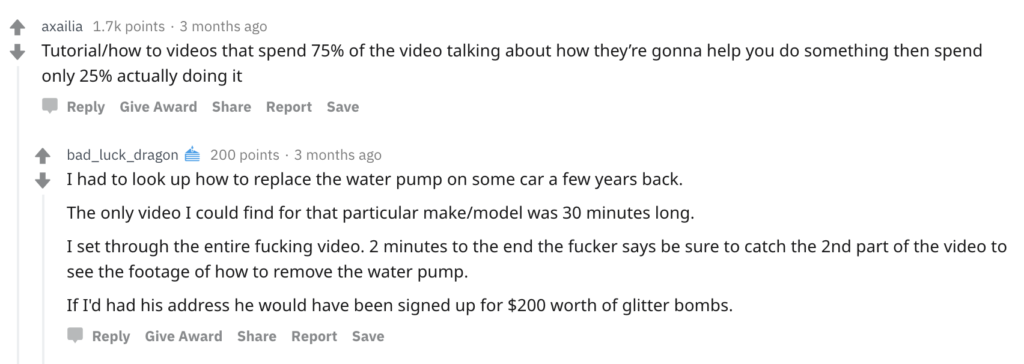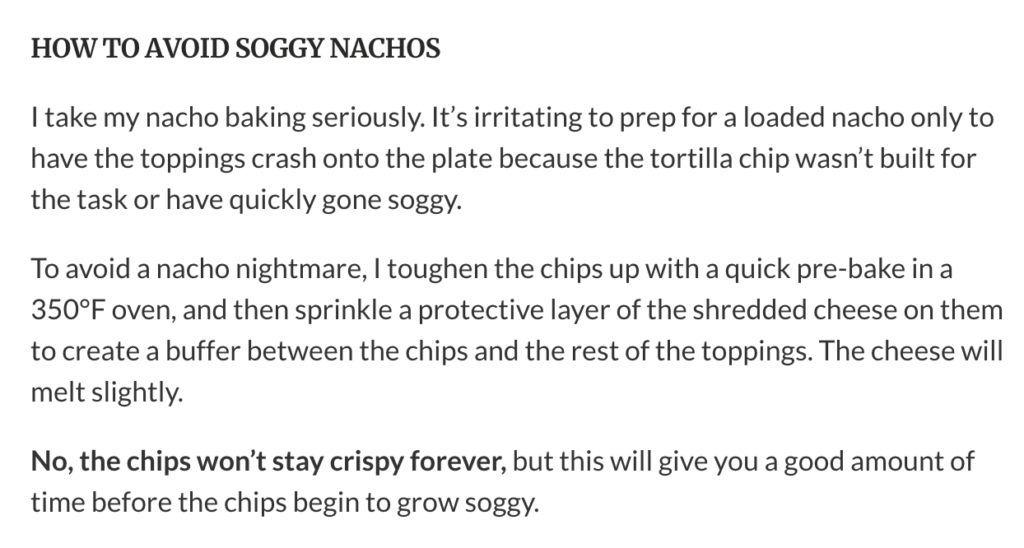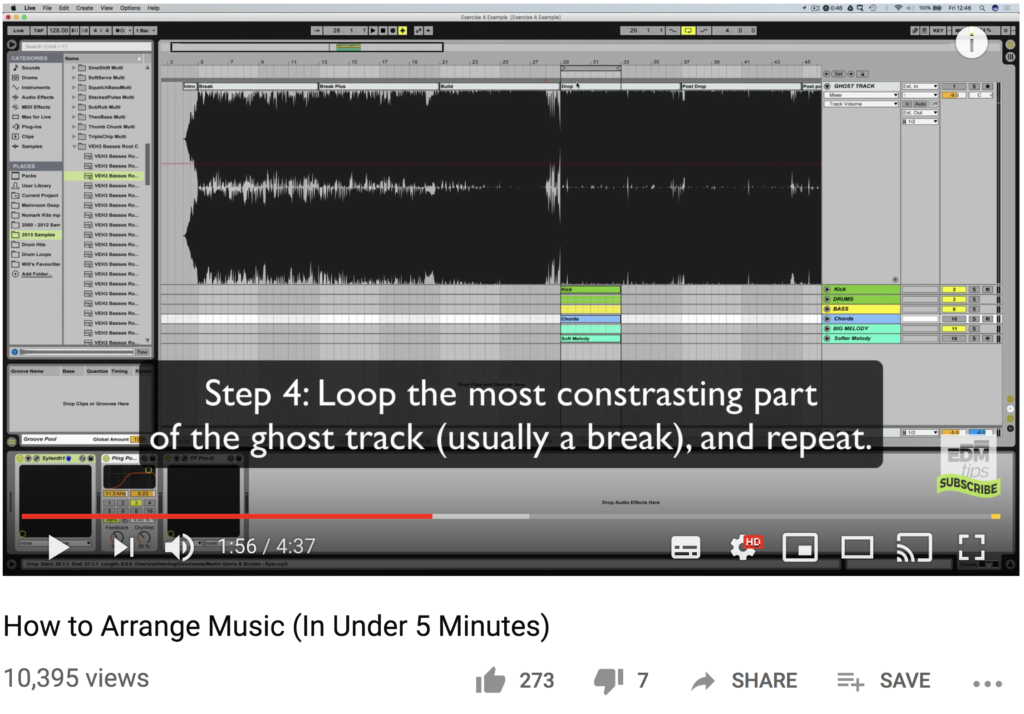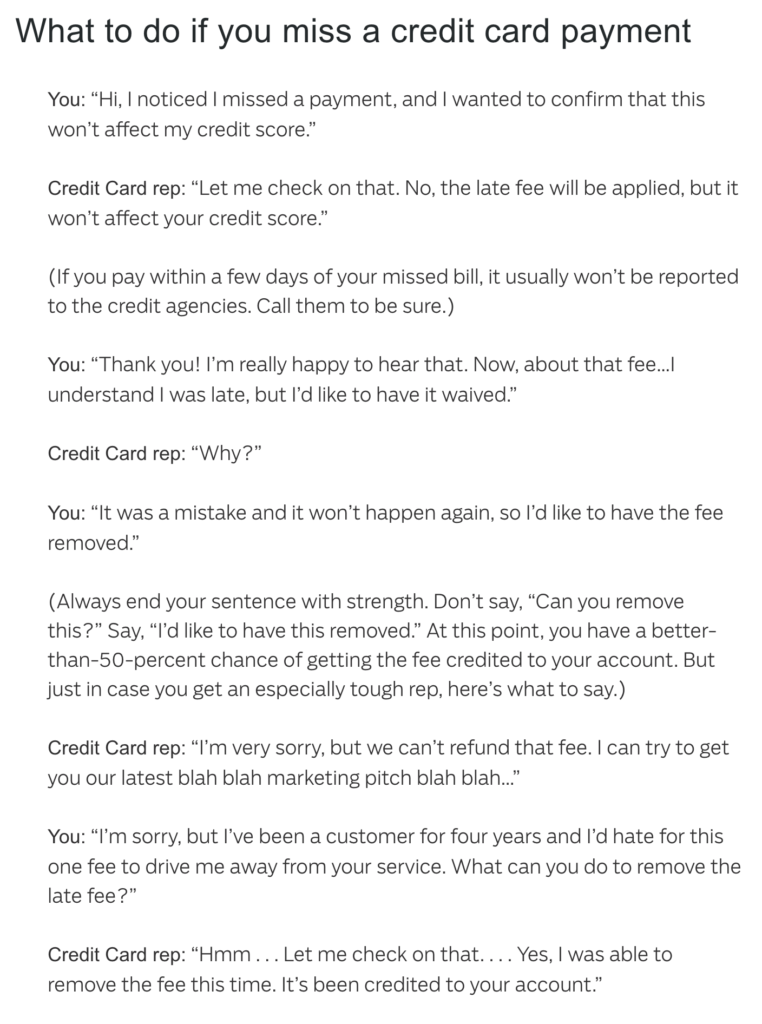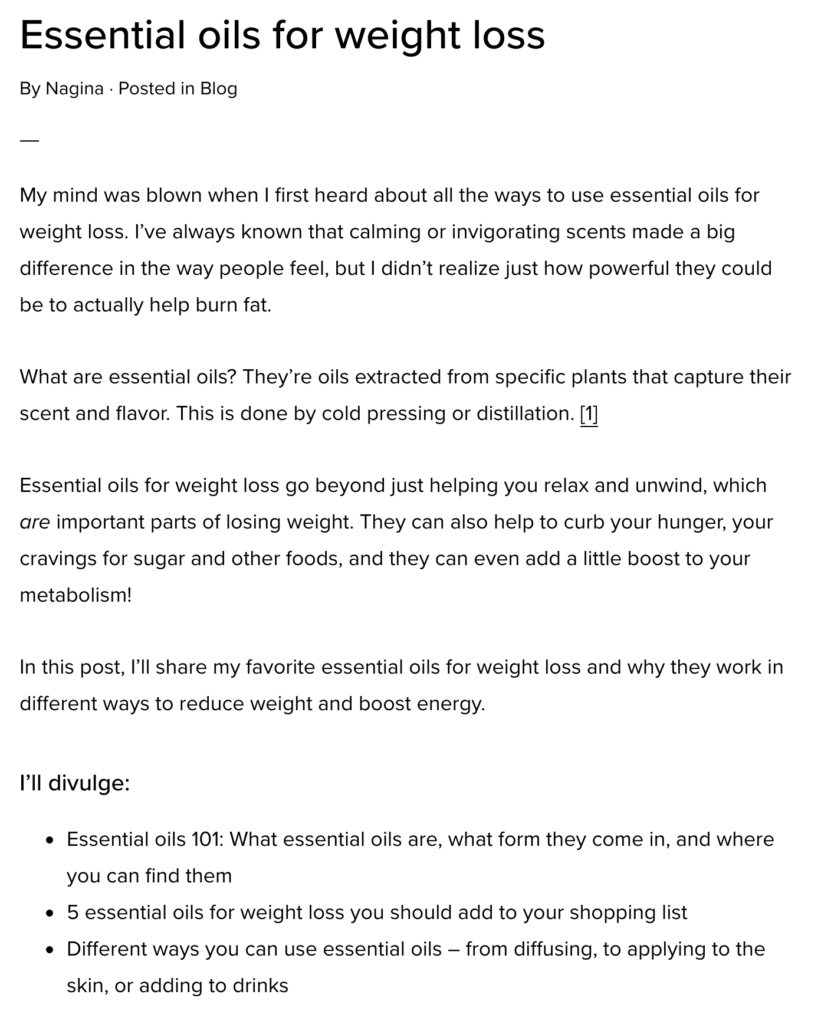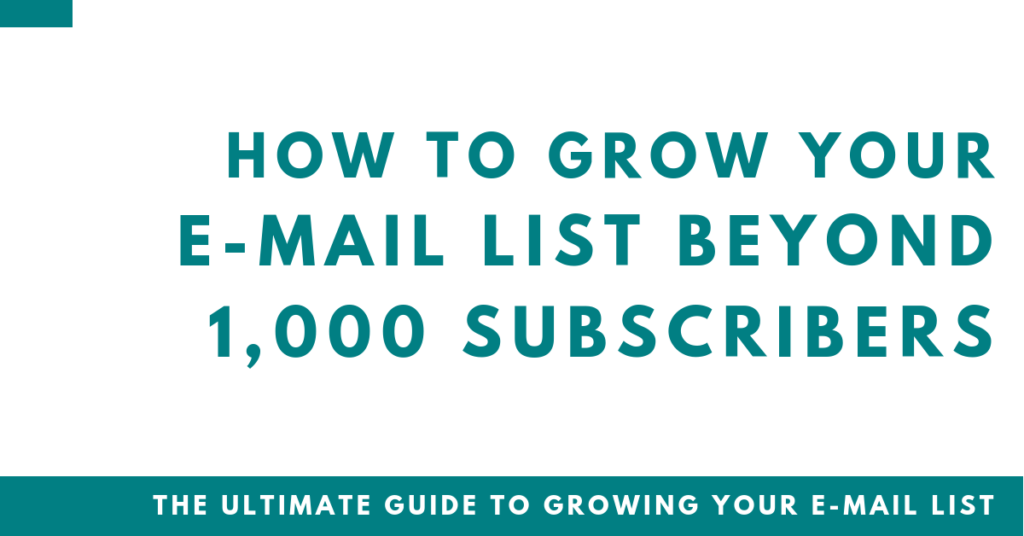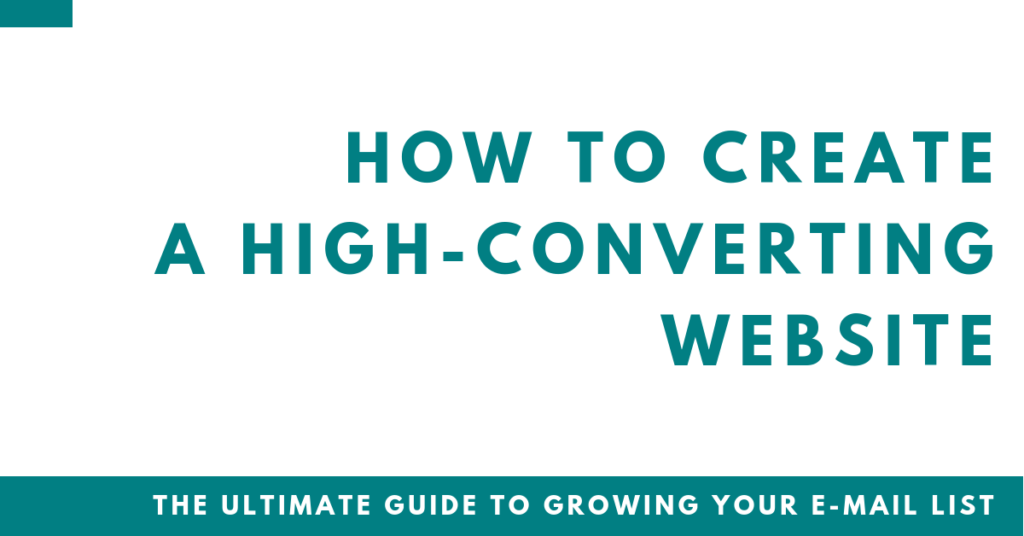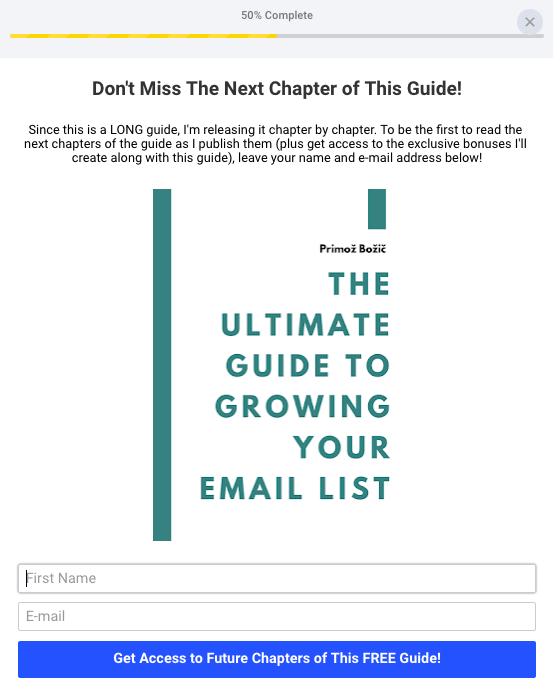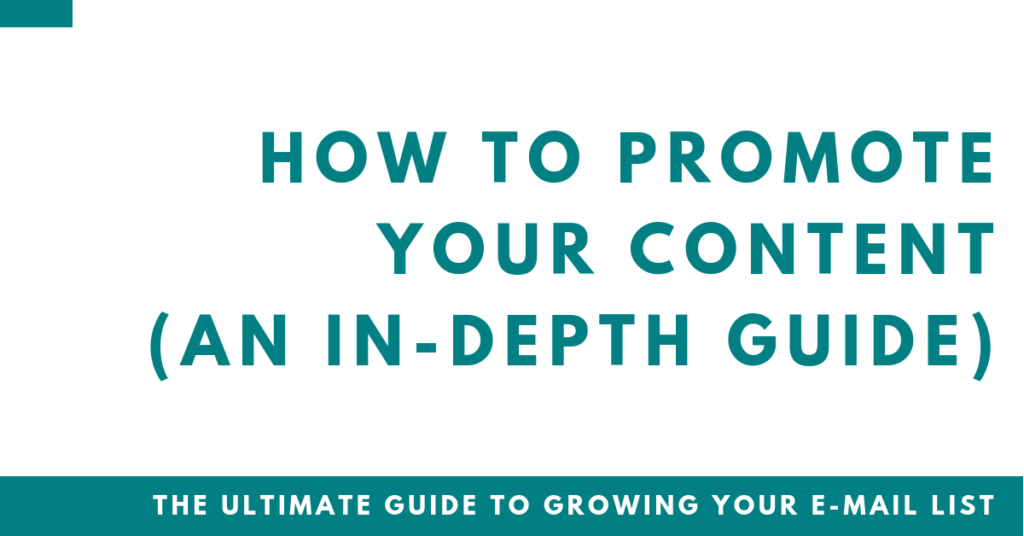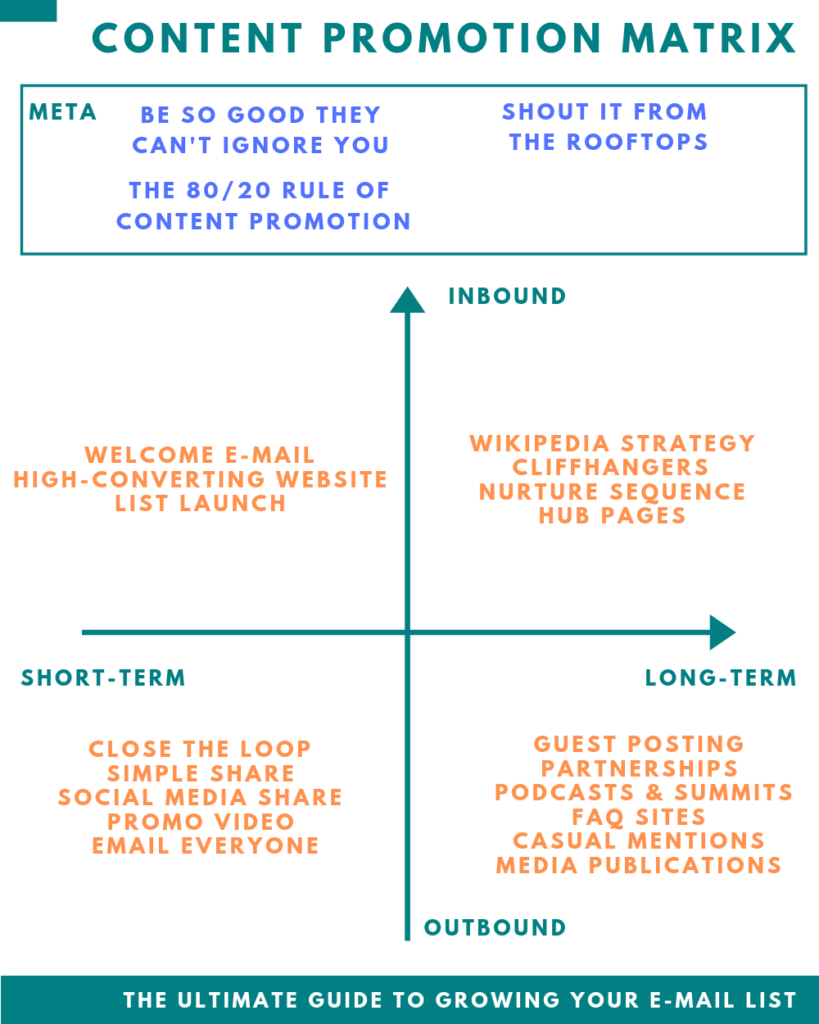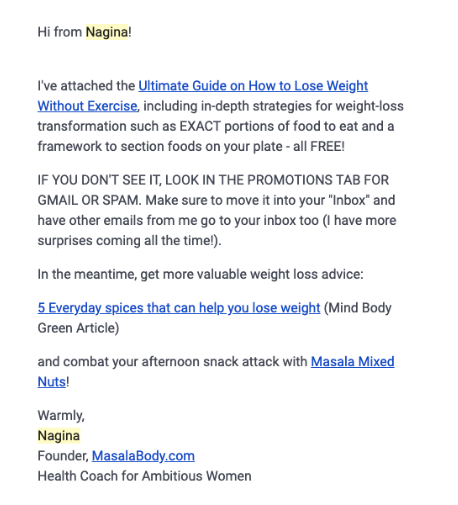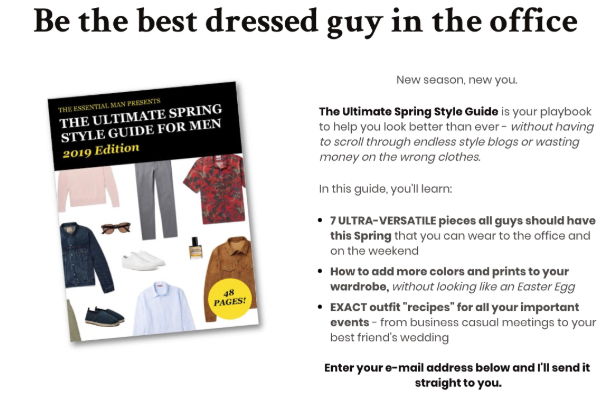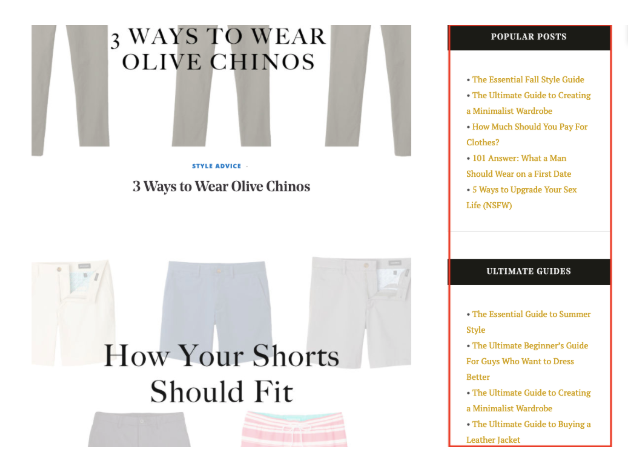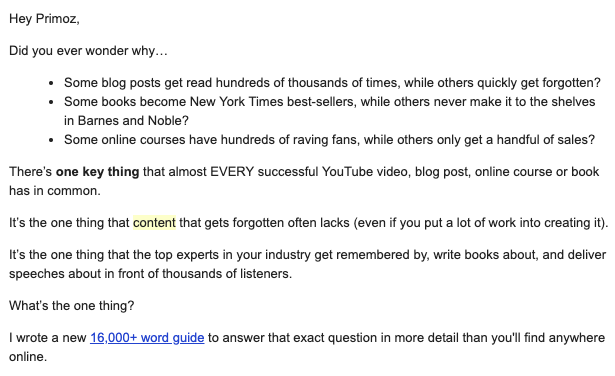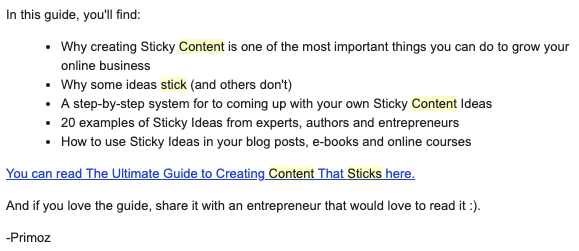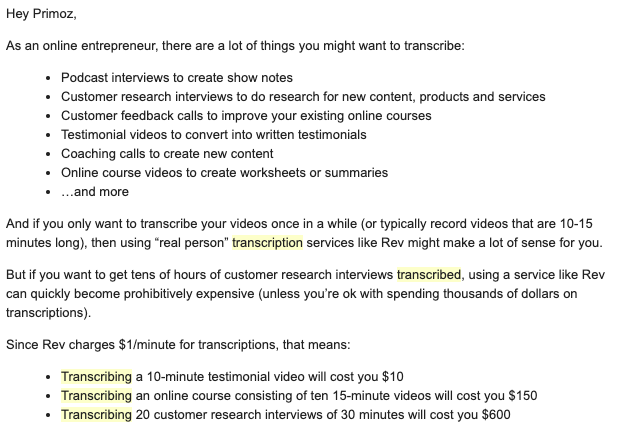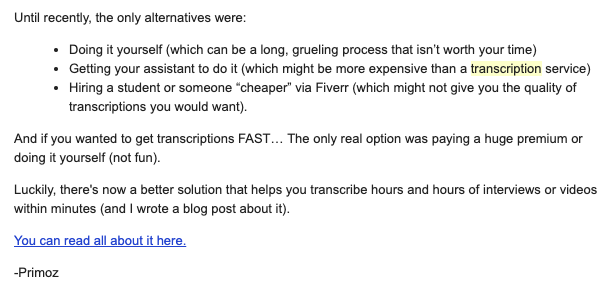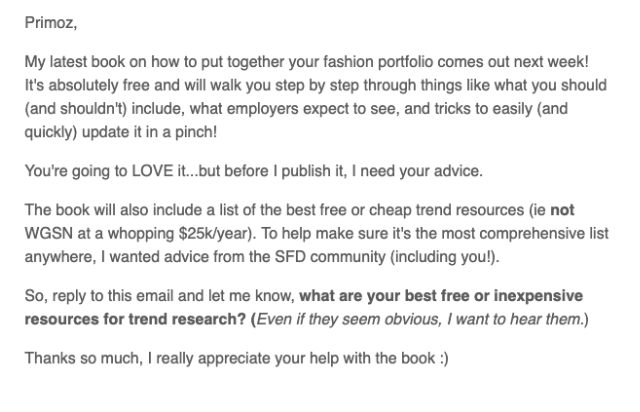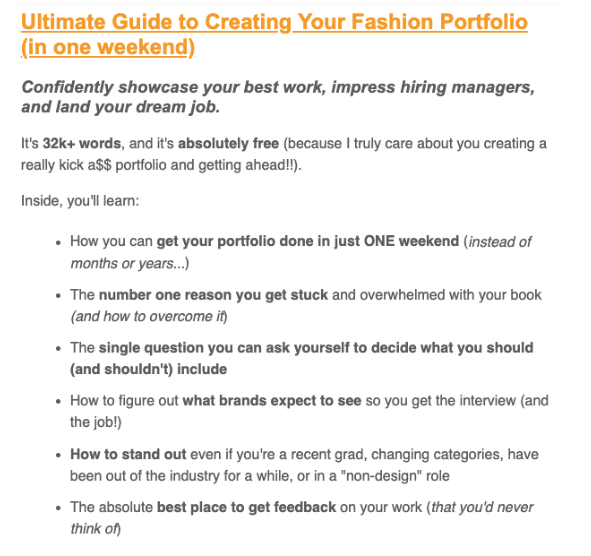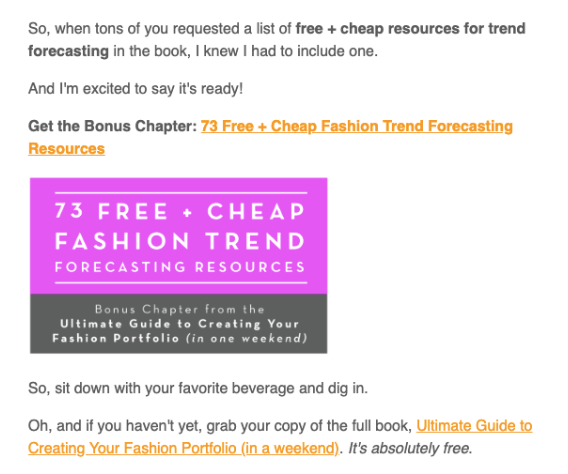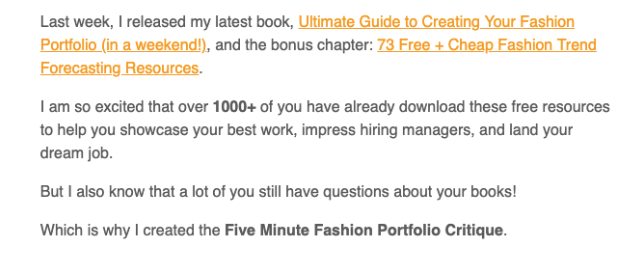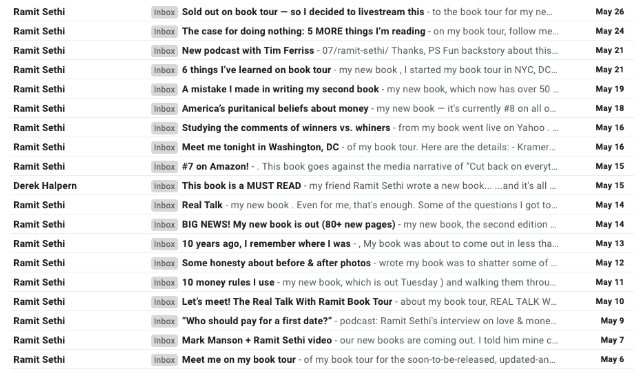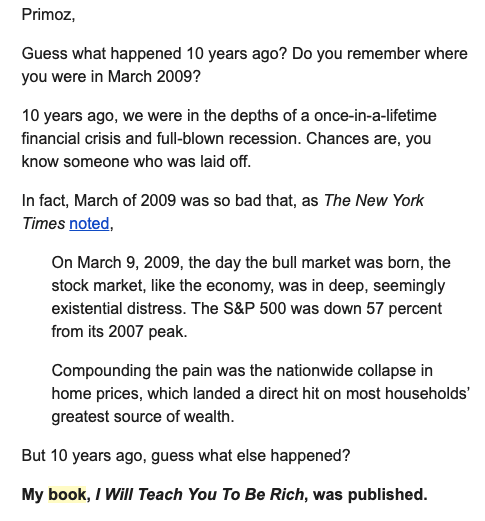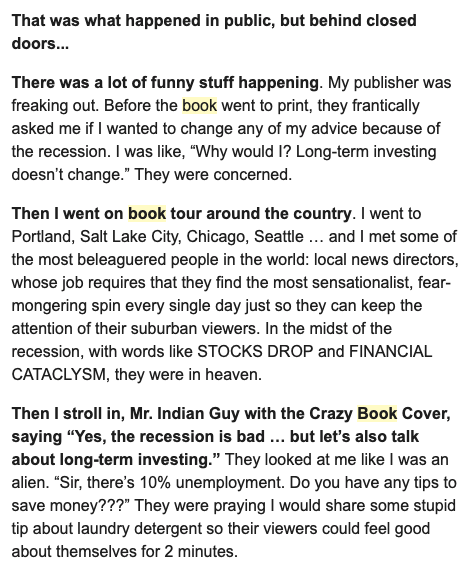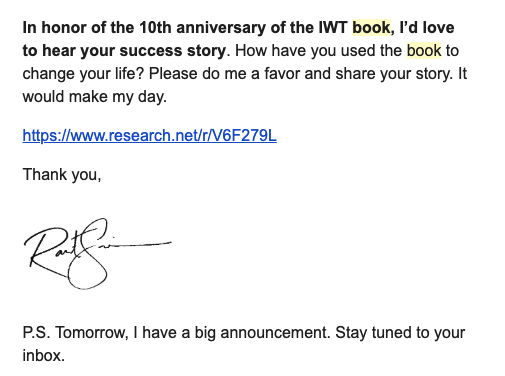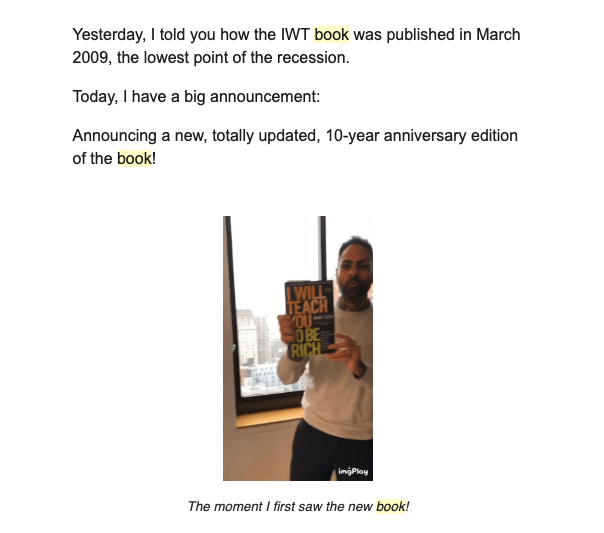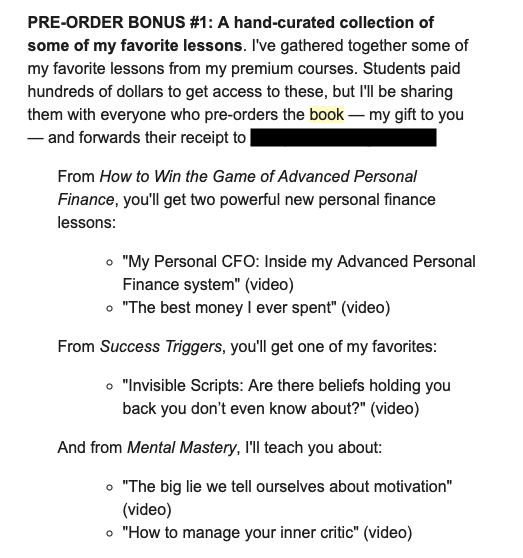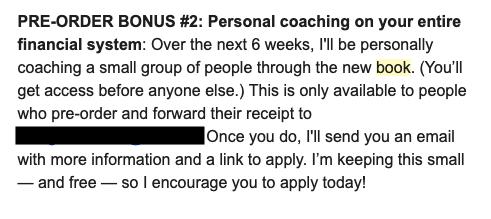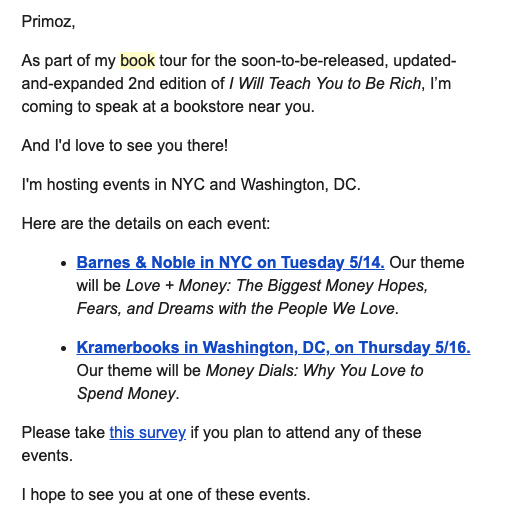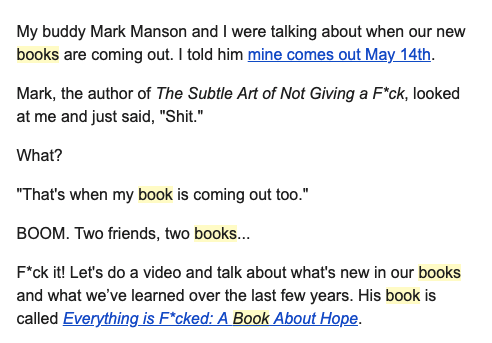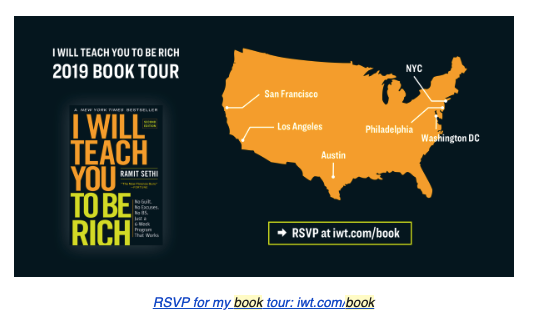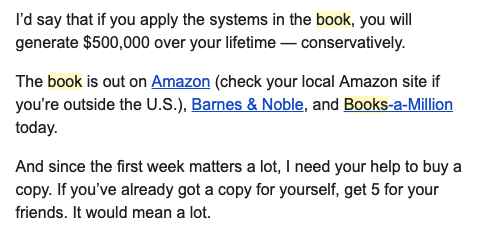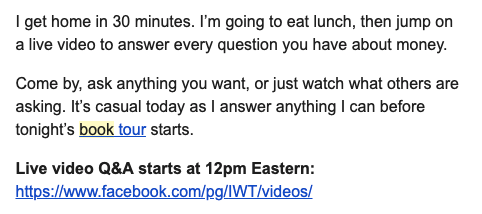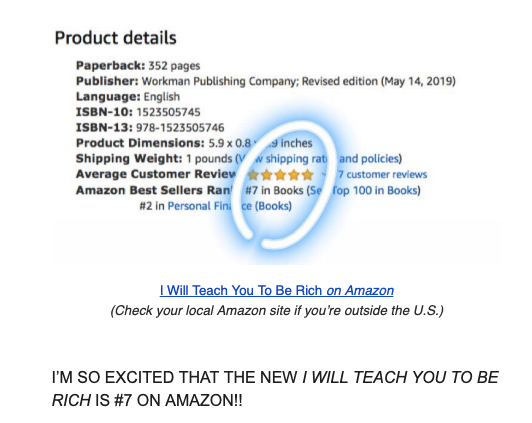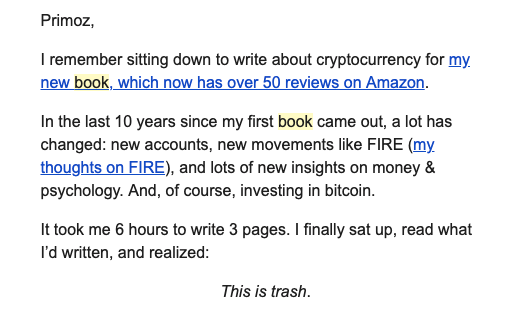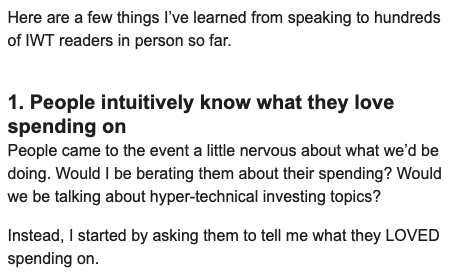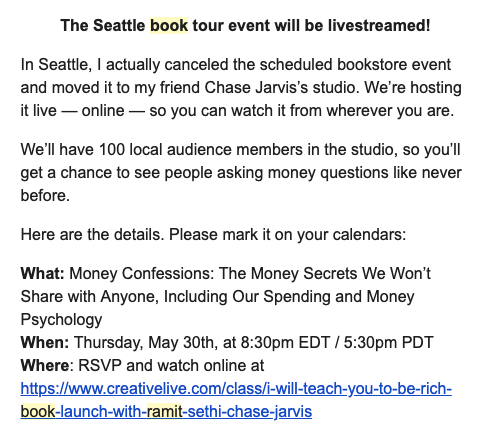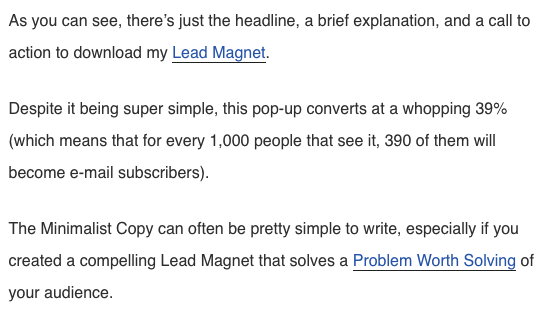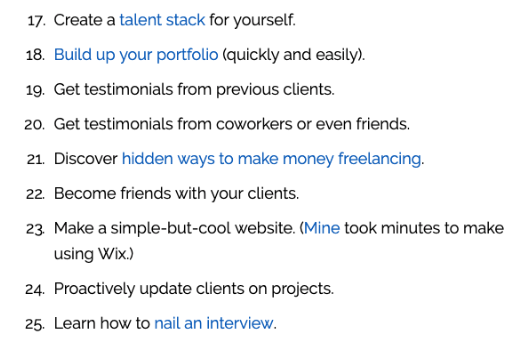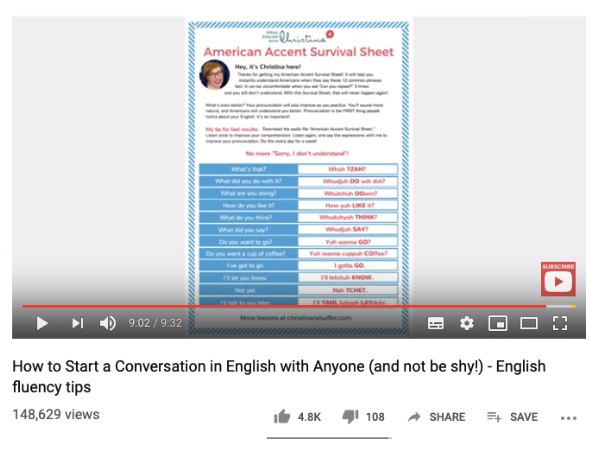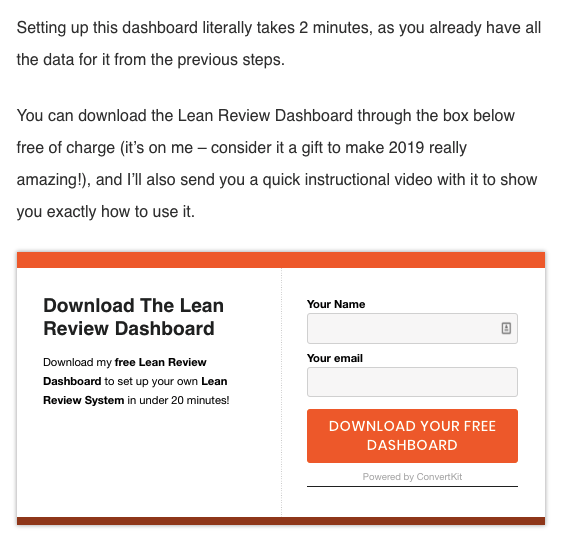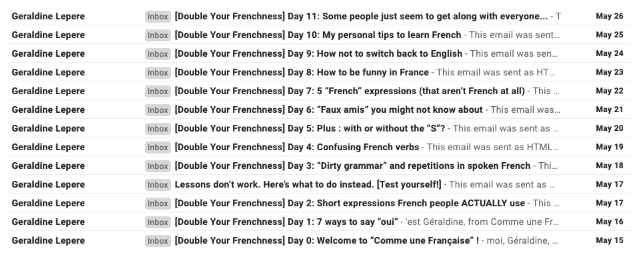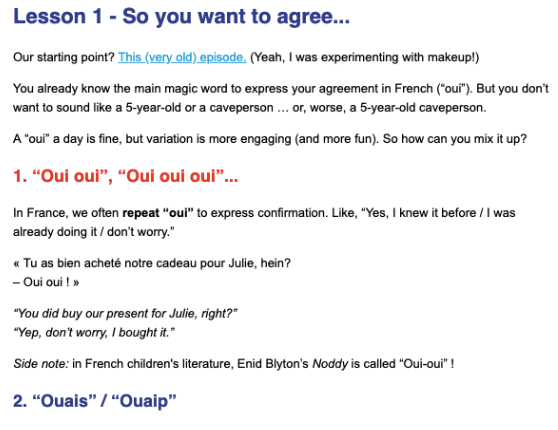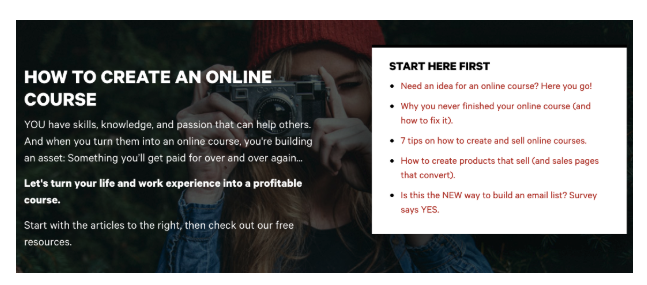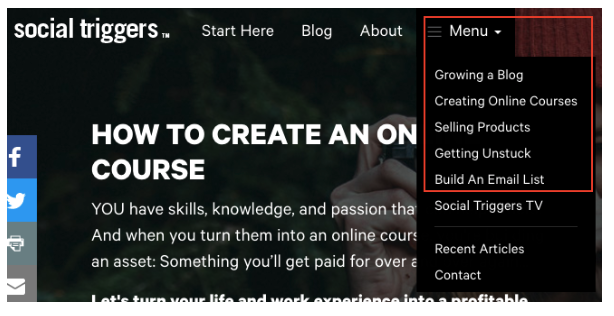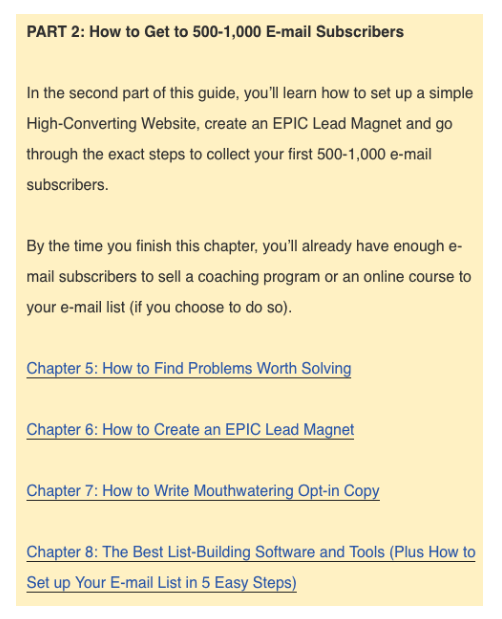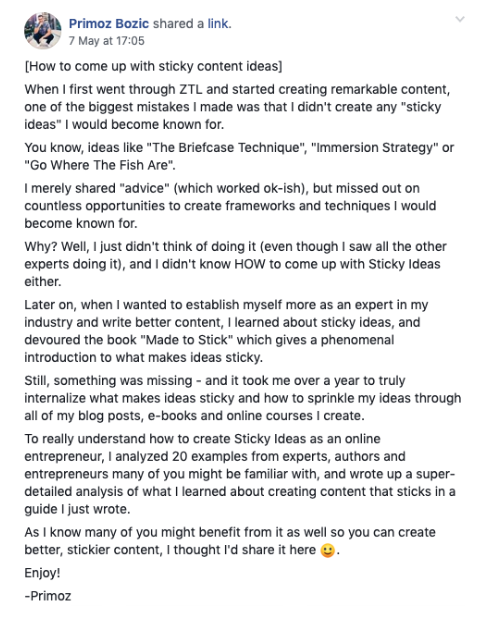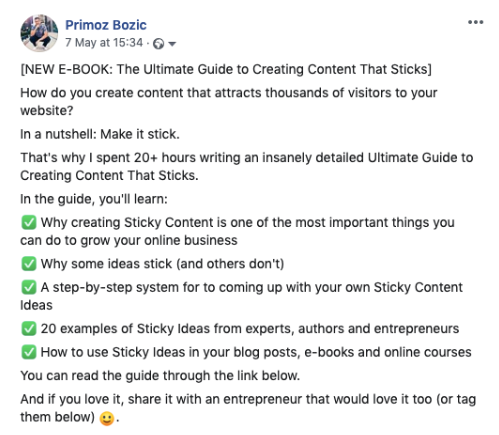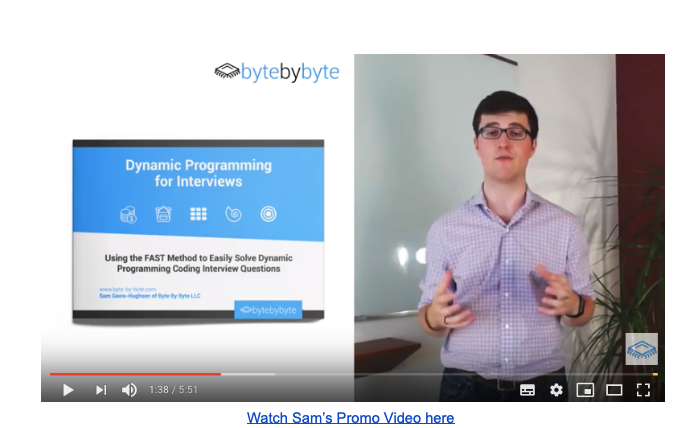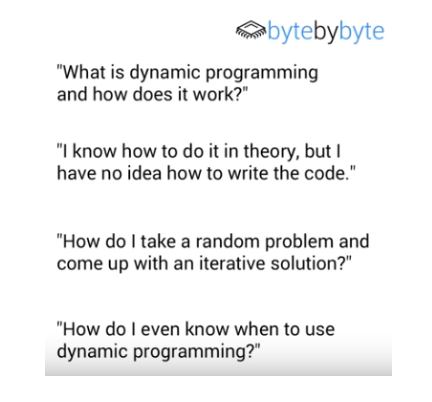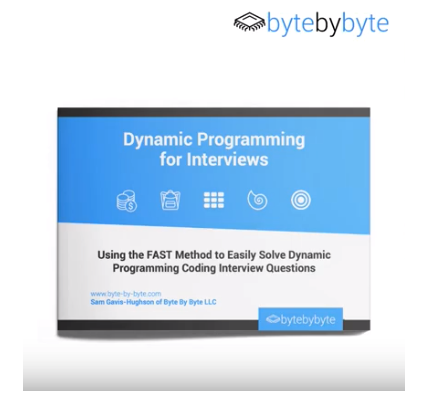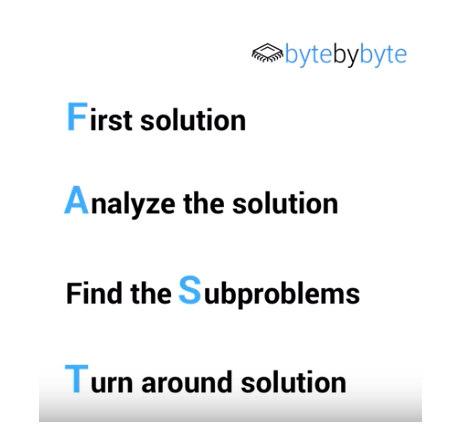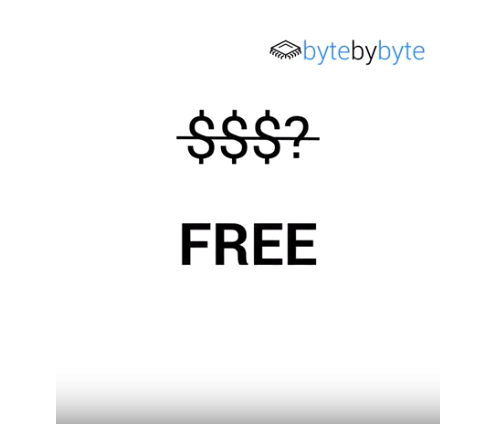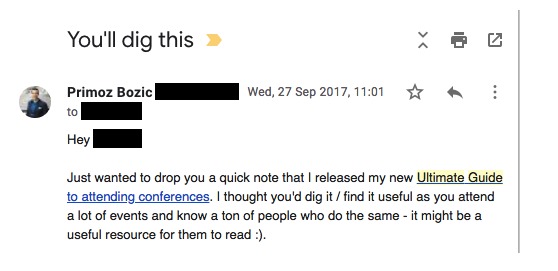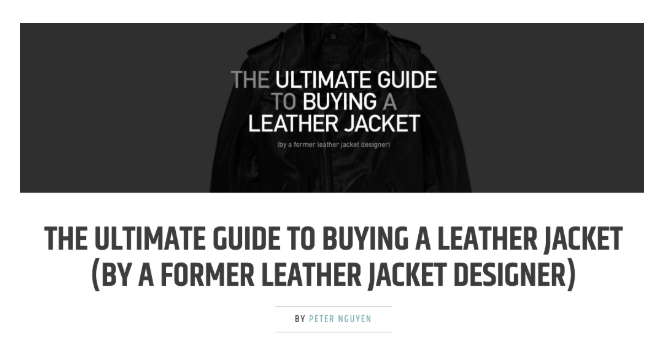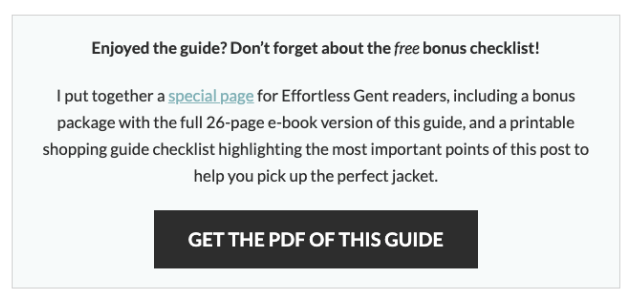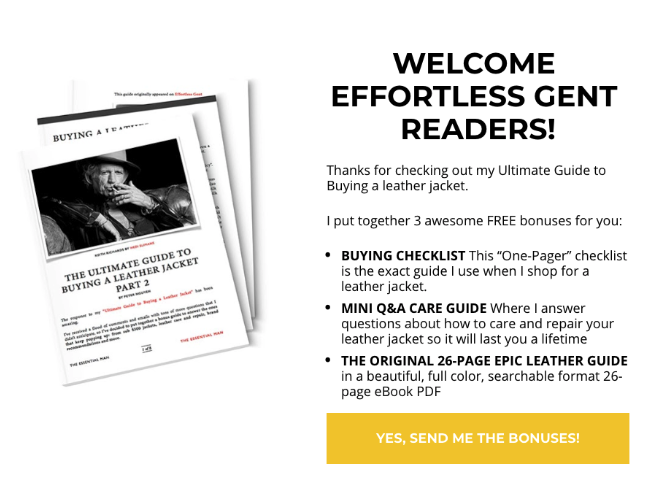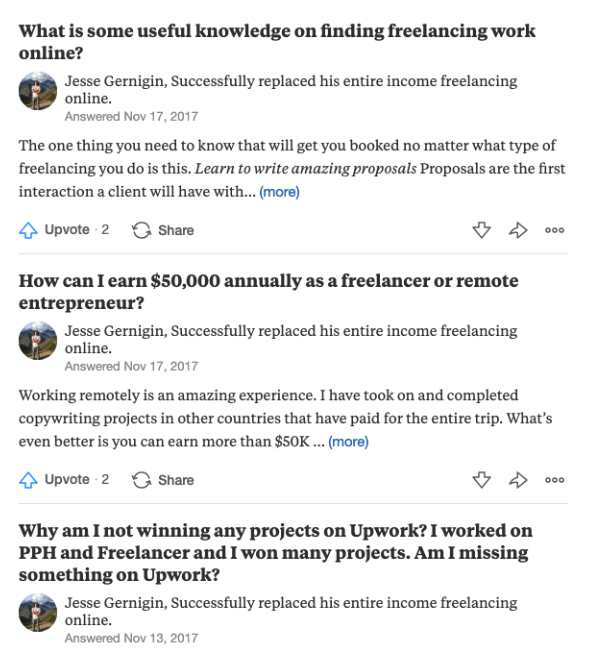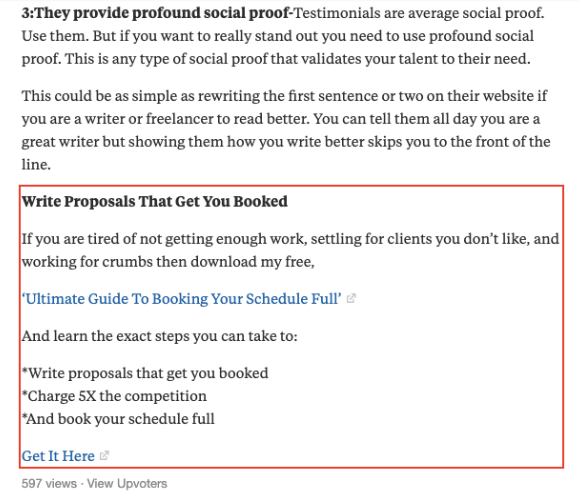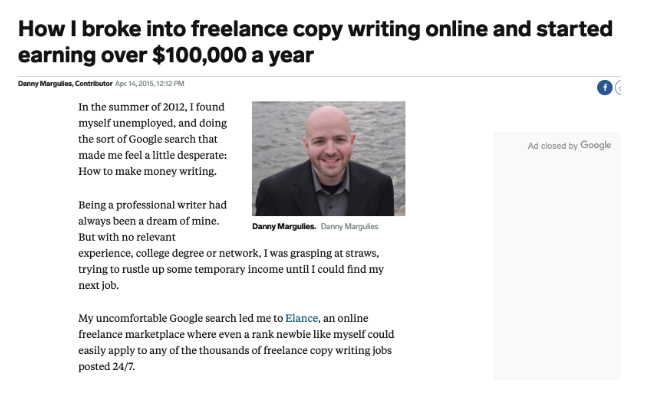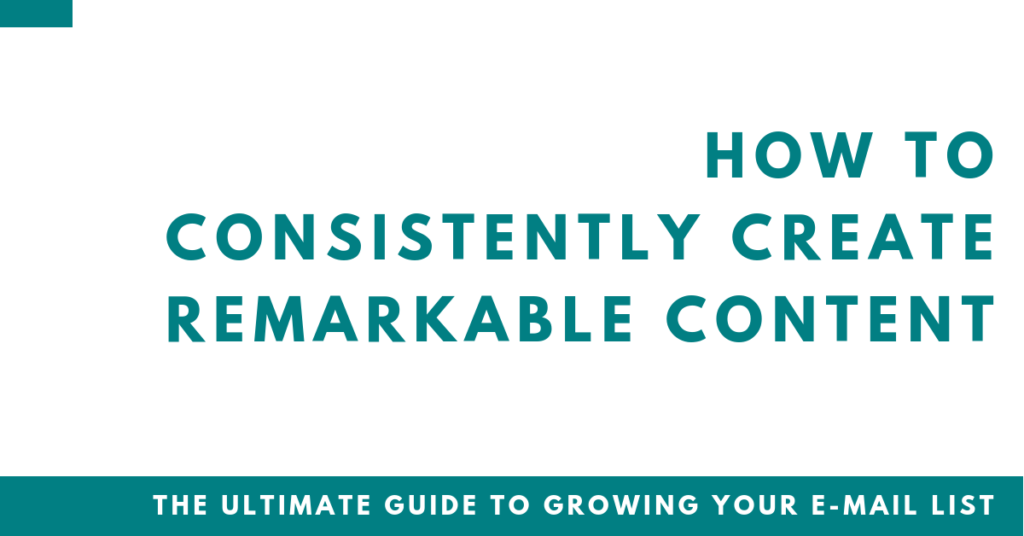
You’re currently reading Chapter 14 of The Ultimate Guide to Growing Your E-mail List.
If you’re reading this, you probably know that consistently creating remarkable content is one of the most important things in your business.
The more remarkable content you can consistently create, the more traffic you’ll get to your website, the faster your e-mail list will grow, and the more sales you’ll get for your online courses, coaching services, and other online products you offer.
But how do you CONSISTENTLY create remarkable content week after week, month after month, while juggling all the other things you need to do in your online business (research, product development, product launches…), and without burning out?
Knowing that is important because without consistent content creation, your business will sooner or later plateau (or worse, start falling apart).
Creating content consistently is the foundation that brings a stream of new potential customers to your business every week, and if that foundation breaks, so can your business.
That’s why, in this guide, I’ll teach you how to create content consistently, once and for all.
NOTE: If you don’t know how to create Remarkable Content yet, you should read my Complete Guide to Creating Remarkable Content first.
Why is it so hard to consistently create remarkable content?
If you know how important it is to create remarkable content, then why is it so hard to create it consistently?
In a nutshell, it’s because 3 things get between you and content creation.
- Your business get in the way: You get busy with developing and launching a new online course or a coaching program, you run out of time and energy to create content, and put it on the back burner
- Your life gets in the way: You move to a different city, your wife has a baby, you get sick,… and slowly but surely stop creating content consistently
- You get in your own way: You sometimes just don’t feel like writing – maybe you’re too tired, too bored, or simply don’t feel like it
Once you manage to get a good handle on all of those roadblocks and obstacles and build the skill of creating content consistently (regardless of what life, business or you throw your way), you’ll emerge out of the content creation as a victor, not the victim.
Build consistency first, THEN increase volume
The default strategy for creating more content seems to be “just buckle down and work harder”. And as you probably know, that doesn’t work well for very long.
It usually results in going on a content creation rampage, spending a few days vigorously creating content, quickly burning yourself out, and not creating any content consistently for weeks (or months).
It’s very similar to going to the gym consistently – a lot of people hit the gym hard every January, and only a few % of them keep going after 2-3 weeks.
So what’s the secret to consistently create new content for your online business every week?
It’s to focus on consistency BEFORE volume.
This means that you should focus on creating content every week, rather than focusing on how much content you create.
That’s because ONCE you’re in a habit of creating consistently, and it becomes natural for you to create content every week (and perhaps even harder NOT to create it), you can easily ramp up the volume and write twice as much every week or record twice as many videos every week.
But if you haven’t built that consistency yet, you can try ANY strategy to create more content, and it’s likely not going to stick. Instead, you’ll enter a vicious cycle of intense content creation, followed by burnout, dry spells of content creation and frustration.
How to develop consistency: Lessons from my fitness transformation
I used to be a fat entrepreneur. I ate out at fancy restaurants multiple times a week where I consumed bottles of wine alongside tasty tasting menus.
In the meanwhile, I stopped doing any sort of sports and spent most of my days in front of my computer.
I quickly got into the absolute worst shape of my life, where my belly fat literally fell over my shorts, and I couldn’t button most of my shirts (photo on the left):
I knew that I had to do something about it, and in January, I decided to do something I dreaded, but just saw no other option anymore:
I joined a gym.
I hated the idea of joining a gym because I didn’t want to become one of those meatheads with lots of muscles that acted like idiots.
But since going to the gym was the most convenient thing for me to do, I gave it a shot anyway.
From past experience, I knew what didn’t work for me:
- Finding a “perfect” workout plan (I would spend more time finding a plan than working out)
- Doing intense workouts every day (I would get so sore after a week I would stop working out)
- Going on a crazy diet (I would stick with it for a few weeks, then start binge-eating all the sweets and junk food I would see and make it all back and more)
So this time, I took a different approach.
I hired a personal trainer, told him about my goals (I wanted a six pack in the summer), and let him guide me.
I was fortunate enough to find an amazing personal trainer that I got along with really well, and all of a sudden, my workouts weren’t a chore anymore. They were something I looked forward to every day.
During my workouts, we focused on doing exercises I enjoyed and was good at (heavy bench presses), and didn’t do exercises I hated or I was bad at (lunges or treadmill).
Because I had the extra accountability and I enjoyed working out with my trainer, I rarely skipped a workout, even if I felt sore, didn’t feel like working out, or had a workout at 7am. I always showed up, regardless of how I felt.
That’s how I managed to get my summer six pack (on the right above), but I didn’t stop there.
I built such a strong workout habit that I continue to work out 4 times a week (often for 2-3 hours a day), and I haven’t missed a workout in years (I work out even when I’m traveling or on vacation).
I even began to enjoy working out so much that I’ve won multiple gold medals at Powerlifting National Championships.
None of this would have happened if I didn’t actually ENJOY working out and built a habit that was easy for me to stick with. It wouldn’t have happened if I tried a crazy workout regimen right from the start.
But because I built consistency first, and enjoyed my workouts, I could gradually increase the weight I lifted, how hard the workouts were, how long the workouts were, and how strong I ultimately became.
Now I can bench press 350+lbs and squat 500+lbs, but to do that, I had to start with just showing up in the gym, enjoying my workouts, week after week.
When I set on a mission to crack the code to consistent content creation last year (where I also worked with 20 online entrepreneurs closely to help them create more content than they ever created before), I realized that creating content consistently works in the exact same way as going to the gym consistently.
Here’s what I’ve found you DON’T NEED to worry about (until you are creating content consistently):
- Coming up with a perfect content calendar
- Nailing your writing and editing process
- Creating the perfect outline
- Going from 0-10,000 words a week overnight
- Knowing if your writing is “good enough”
None of those things matter.
You can figure them out ONCE you learn how to consistently create remarkable content, but if you focus on them before nailing consistency first, these techniques will work for a while until you hit another dry spell of content creation.
First, you need to make content creation fun, exciting, and easy to do, and get to a place where it’s harder for you not to create content every week than it is to create it.
How to make content creation exciting (rather than a chore)
Sometimes, creating content can feel like a chore, or you’ll feel an insane amount of pressure around it, that will drain you more than the actual content creation itself.
This might happen when you’re just starting out with content creation and you aren’t used to it yet, or at a certain point when you build a large enough following and you all of a sudden feel like people have these huge expectations around every piece of content you publish.
Having been there plenty of times myself, here are the strategies that helped me cope with the pressure and make content creation fun and exciting (rather than a chore).
Strategy #1: Just get to the coffee shop
When I started out with creating content, I thought that setting goals and benchmarks like “writing 1,000 words every day” would help me stay on track with my content.
It didn’t. That approach might work for some people, but it never worked for me.
There’s something else that did work FAR better than any other trick or hack, and it’s deceivingly simple:
Just get to the coffee shop!
For me, coffee shops are the place where I get 99% of my writing done.
Maybe it’s the because I get out of the house (and don’t get distracted by laying in bed or finding all sorts of things to clean or move around in my apartment).
Maybe it’s that there are other people around me and I don’t want to “slack off”.
Maybe it’s the endless supply of delicious coffee that keeps me going.
Maybe it’s all of the above.
What I do know is that whenever I get to the coffee shop, I get writing done, and writing is my main source of content creation.
When I’m at the coffee shop, I’m focused, I’m writing, and write thousands of words every day.
Focusing on getting to the coffee shop whenever I want to create content has ironically worked way better (and often helps me write 4,000+ words a day) than setting a goal of writing 1,000 words.
This simple strategy has worked for a lot of my clients as well – as long as they got to the coffee shop (or the library / coworking space for some entrepreneurs), the content would automatically get created.
Try it out and see how it works for you. And even if you want to create YouTube videos, you can use the same strategy to write scripts for them ;).
Strategy #2: Create content you WANT to create (not “should” create)
Whenever I look at any of my content creation dry-spells, the culprit behind them is almost always the same.
I focused on creating content that I felt like I “should” be creating (that my clients or coaches told me to create), rather than content I really WANTED to create.
As soon as I gave myself permission to create content around things I wanted to write about, all the pressure seemed to disappear, and I found myself making the extra time to create content, EVEN when I was tired.
As we already touched on in the guide on creating remarkable content, you should always start by creating content you’re most excited to create.
You’ll likely never create 80% of the content you have ideas to create (because you’ll have more ideas for content than time to create all the content), so you might as well spend your time and energy on the 20% of ideas that DO excite you than the ones that don’t.
Strategy #3: Create content in your Zone of Genius
Similarly to the topics you want to create around, you should also choose the formats or content types that are in your Zone of Genius:
- You should create content in a way that’s FUN for you to create (if you love writing, write; if you love talking, make videos)
- You should create content that you’re GOOD at creating (if you’re good at writing long guides and bad at writing short blog posts, write long guides and don’t write short blog posts)
I can’t stress this enough – choose the content type and platform that suits you, and creating content will be SO much more fun and exciting.
At the end of the day, you can make a choice:
- You can create the content you “should” be creating in a way you “should” create it (and likely spend more time procrastinating than actually creating content)
- Or, you can create content that you WANT to create in a way you LOVE creating content
By taking the first approach, you won’t please anyone, and you’ll waste weeks or months feeling frustrated.
By taking the second approach, you’ll create A LOT more content, help a lot more people, and even if not all of it is “perfect”, you’ll feel like you spent your time a lot better than you would by trying to “get” yourself to create content.
Strategy #4: Focus on solving problems, not numbers
When you’re creating content, it’s easy to get lost in numbers (from daily traffic to page views to bounce rate to new e-mail subscribers every day) and spend hours and hours refreshing your analytics.
While you’ll likely go through this phase, the sooner that you can get out of it, the better.
Analytics are a great way to analyze which of your content is resonating and which isn’t (in fact, I recommended looking through your statistics by doing a Channel Audit in a previous chapter of this guide).
However, obsessively checking your numbers multiple times a day won’t do much for your business.
To prevent yourself from doing this all the time, I suggest doing two things.
First, check your analytics once a week. I like to check them every Monday morning, during my 2-minute weekly review.
Second, focus on solving problems, not numbers.
Instead of becoming obsessed with analytics like many internet marketers, become obsessed with solving people’s problems.
That’s what I focus on when I’m writing. I’m not thinking “I want to get X traffic this week”. I’m thinking “I want to write this post as soon as possible so I can help people with advice in my head”.
Try taking on this mentality, and see how it goes!
Strategy #5: Shoot for clarity over perfection
When you’re just starting out with content creation, it’s easy to pressure yourself into creating “perfect” content, which can kill any chances of you creating content consistently.
I asked Luke McIntosh who has created weekly YouTube videos for more than a year to grow an e-mail list of 25,000+ e-mail subscribers how he deals with this issue:
“Your first few YouTube videos / blog posts will suck. Make as many as you can, get better over time. Shoot for clarity over perfection, shoot for not being misunderstood. “
This is a great mindset to take on, and when you look back at your content 6 months from now, you’ll probably cringe at what you created, regardless of how “perfect” you try to make it.
The only way to create the “perfect” content is by creating more content, and getting better at creating content over time.
To get better at creating content, you need to get in the practice, trial and error, create hundreds of pieces of content, and get better with every piece of content you create.
It’s just like practicing basketball. You won’t become a great basketball by waiting to make one perfect shot for 10 hours. You’ll become a great basketball player by making 10,000 shots, having a coach watch you, and improve with every shot that you make.
After 10,000 shots, you’ll shoot the basketball a lot better than after 1 shot.
When you’re just starting out with creating remarkable content, focus on making your content clear and remarkable, and creating it around problems worth solving.
Create 10 or 20 pieces of content, listen to the feedback you get, and make changes with future content you create to get better and better at creating content (and get more and more traffic and e-mail subscribers).
The 5 reasons why you aren’t creating content consistently (and how to fix them)
To create content consistently, it’s not enough to just “start creating conent”, as your life, your business, and you will keep getting in your way.
Instead, we need to strategically prepare for battles with our enemies that stand in the way of creating content consistently.
There are 5 “horsemen of content creation apocalypse” that will stand in the way of you and creating remarkable content consistently:
- Time
- Energy
- Distractions
- Thoughts
- Boredom
In this guide, I’ll share with you the exact weapons you can use to defeat these horsemen and build a bulletproof content creation habit.
By having these weapons in your arsenal, you’ll be able to keep creating content EVEN when your life, business, or you get in your way.
How to Find Time to Create Remarkable Content
Finding the time to consistently create content can be rough, especially when life or business gets in the way.
Whether you’re working on creating and launching a new online course, you’re doing an intense week of customer research calls, or you’re laying sick in bed, barely able to move, there’s always something that life will throw your way that cuts into your precious content creation time.
If you don’t create and protect the time and space to get your content creation sessions in, it’s very unlikely you’ll build a consistent content creation habit, as content creation will quickly move over to the back burner.
This is one of the main reasons why most entrepreneurs fail with consistent content creation – they just try to “create more content”, on top of everything else they’re doing in their business (though they of course do make time to check e-mail and social media daily).
When more urgent work comes in-between or we “don’t feel like it”, we quickly drop the ball on content creation.
Luckily, there are a quite a few weapons we can use to fight this horseman and ALWAYS make the time to create content.
Strategy #1: The Lean Schedule
The very first thing we can do to create more time for content creation is to create a Lean Schedule, a concept I wrote a detailed blog post about that I highly recommend you to read.
Creating a Lean Schedule consists of 3 simple strategies:
- High-Impact Work Audit: Take a deep, hard look at which tasks in your business actually move your business forward, and which tasks you’re doing just because you “should” be doing them or you’re used to doing them, even though they don’t do much for your business
- Time Purge: Purge all of your Low-Impact work out of your business, to create more time for High-Impact Work (like Content Creation)
- Schedule Overhaul: Reorganize your schedule, meetings, errands and client calls to completely free up big blocks of time in your calendar for Content Creation (and ideally block off a few days when ALL you do is create new content)
This way, you’ll be able to turn a cluttered schedule that allows for very little content creation:
Into a lean schedule that gives you plenty of time and space to create content every week:
For example, when I had a cluttered schedule, I only had a couple of “pockets of time” to create content – now I have Mondays, Tuesdays and Fridays blocked off to exclusively focus on content creation.
And even if I’m creating or launching an online course and I choose to spend 1-2 full days on that, I can still have a full day left to consistently create new content.
Creating a lean schedule is the SINGLE most effective strategy for creating more time to create content that works over and over again, so I highly suggest you to read my detailed article about it, follow the steps step-by-step, and implement it in your business.
NOTE: My example above is from running my business full time. Even if you run your business on the side, you can use the Lean Schedule strategy to create uninterrupted afternoons, mornings, or days to create content for your business over the weekend by using the exact same principles and techniques.
Strategy #2: Protect Your Time
Just as it’s important to MAKE time for content creation by creating a Lean Schedule, it’s just as important to PROTECT that time.
As you suddenly find yourself with hours and hours of free time just to create content, it’s easy to distract yourself with everything else – from grocery shopping, getting a haircut appointment, going hiking, or messing around on your computer (been there, done all of that).
It’s natural that when you find yourself with so much free time, you need to create new habits and routines that help you cope with it and actually use the time effectively to create as much content as possible.
To make that happen, you can follow these two rules:
- Only allow yourself to create content, or do NOTHING during your content creation days / blocks
- Protect your time and don’t let anyone steal it away from you
The first of these rules is pretty self-explanatory. When the only possible alternative to creating content is staring at a wall and doing nothing, creating content becomes a lot easier.
The second might need a bit more explanation.
Once you experience huge chunks of uninterrupted time, you’ll have to fight the urge to do all sorts of things during this time:
- Client calls and meetings
- Errands, coffees and lunches
- Fun activities, exercise and hobbies
- Sleeping in
- New projects that could grow your business
You’ll have to develop the discipline to say no to yourself, as well as others, and protect your time.
The way to fight that urge is by creating meeting days (for me, that’s Thursdays and every other Wednesday) where you take all client calls, meetings, and do all of your errands. These might be 1-2 intense days where you’ll feel exhausted by the end of the day, BUT in exchange you’ll have 3-4 days when you can focus just on creating content.
I intentionally schedule my meeting days for Wednesdays and Thursdays so I can create content when I’m the most recovered from my weekend (MON+TUE), and I like to hae the flexibility to take longer weekend trips to recharge on Fridays (if I’m not recharging, I’m creating content, like I am today).
At first, this might be tough, but over the course of a few weeks, you’ll get better at it, and sooner or later, only creating content on your content creating days will become a routine for you.
What you’ll soon discover as you take on this new routine in place is that you can create A LOT of content in 2-4 hours a day, allow yourself to wrap up work earlier (by 2pm or 4pm), and have the whole afternoon guilt-free to do whatever you want – so you’ll be more productive AND have more free time than ever.
Strategy #3: Outsource, automate and delegate Low-Impact Work
Once you’re consistently bringing in thousands of dollars with your business every month, you’ll be able to get rid of certain low-impact tasks that have to get done, but you don’t enjoy and might not be the best use of your time.
At this point, you can think about how to create a few extra hours every week by:
- Hiring a Virtual Assistant to help you with answering e-mails, scheduling client calls, organizing research, designing online course presentations, formatting your blog posts, accounting, doing taxes, or other tasks that aren’t worth your time.
- Hiring a cleaning lady that cleans your apartment, does your laundry, or even cooks for you
- Paying your neighbor’s son to mow your lawn
- Have someone pick up and wash the car for you (or change the tires to winter tires)
- Use a healthy meal delivery service instead of meal prepping
- Paying for software like Calendly to automate scheduling your coaching calls
- Paying for software like Zapier to automate other mundane tasks in your business
This might feel uncomfortable at first, especially if you’re used to doing everything yourself, so you don’t need to do all of these things right away.
Start by outsourcing, delegating or automating ONE task that you absolutely hate and drains your energy, try it out for a week, and see how you like it. If you love it, tackle another one next week (and another one the week after…).
Strategy #4: Develop a Professional Attitude
The final thing you can do to stick with your new schedule is to change the way you think about creating content.
Instead of thinking about it as “just another task on your to-do list”, think of it as the life and blood of your business. The more remarkable content you create, the faster your online business will grow.
You can think of your content creation sessions as a professional athlete treats their training sessions:
- Get into the mindset of a professional, not an amateur
- NEVER skip a content creation session
- Don’t sleep in (if you do, you’re off the team!)
- On bad days, create less content, or focus on creating content that’s more fun to create, rather than skipping your session
- An athlete wouldn’t schedule meetings over their training (or go to a haircut instead), and neither should you for your content creation sessions
Getting into the professional mindset and treating your content creation sessions as training can make a HUGE difference in how much content you end up creating.
Strategy #5: Create Content Weeks (or Months) in Advance
What about when you’re spending all of your energy creating or launching a new online course, or when you’re having an intense rapid research week and do 20 customer research interviews within a single week?
During those times, it’s ok not to create content (but with a twist).
Instead of falling off the wagon and creating a dry-spell in your content (which means a wasted opportunity in growing your e-mail list), you can create content in advance, and schedule it to get published while you’re focusing on other things in your business.
If you followed the Lean Schedule strategy and created a few content creation days in your business, you now have more than enough time to create enough remarkable content every week.
In fact, you’ll be able to create more content than you might want to publish.
To take advantage of this time, you can use these content creation sprints to create content that you’ll publish a few weeks (or months) in advance.
For example, if you can write 2 remarkable blog posts a week but you only want to publish one blog post a week, you can create 8 pieces of remarkable content in 4 weeks, which means you could take 4 weeks “off” from content creation to focus on developing or launching a new online course (or even taking a well-deserved vacation).
That’s exactly what Luke McIntosh from Become a Bassist did when we worked together on creating more content consistently:
“I wrote 9 weeks of content in advance so I could take a 6-week holiday in Brasil while my business kept growing. Even though I haven’t been ‘working’ on my holiday apart from responding to emails and things like that, I’ve still brought in just under 2,500 new subscribers.”
Once you get used to creating content weeks or months in advance, it becomes surprisingly easy to keep up with all the other work in your business.
By freeing up the content-creation days, you can then use those days for research, course development or writing sales copy – while knowing that your business is growing in the background through all the content you already created.
How to Find The Energy to Create Content (Even When You’re Tired or Don’t Feel Like Working)
Having the TIME to create content is one thing.
But feeling like creating content is another. There will be days when you’re distracted. There will be days when you’re tired. There will be days when you’re laying sick in bed. There will be days when you just don’t “feel” like creating content.
Before we get into specific strategies for finding more energy for creating content, we need to get one big myth out of the way:
“I can’t create content when I’m tired / don’t feel like it”.
I used to believe the same thing – but through my research (and writing 10,000+ words week after week), here’s what I realized:
It’s not impossible to write when you “don’t feel like it”, or when you’re tired.
For example, as I’m writing this guide, I’m tracking all of my writing sessions in my writing tracker.
And while I have some weeks when I’m bursting with energy, there’s plenty of weeks, days, and sessions when I’m tired and don’t really feel like writing.
For example, this Monday and Tuesday, I was pretty tired (my energy levels were around 3 on a scale of 1-5 most of the time, which is fairly tired, but not dead tired), and I still wrote for 3+ hours and 4,400+ words every day to create my Remarkable Content Guide:
What’s surprising is that even though I was tired (and it was definitely harder for me to sit down and write), I was pretty focused while working most of the time (my focus was a 4-5 on a scale of 1-5).
This is a trend I’ve seen over and over again in my own content creation, as well as by working with other entrepreneurs to help them create more content:
- If you’re dead tired (1-2 energy), it is indeed difficult to create content
- If you’re tired (3 energy), it’s harder to sit down to create content, but once you get started, you can get in the flow, forget about time and create A LOT of content
- If you’re fresh (4-5 energy), it’s the easiest to create content, BUT only 20-30% of your content creation sessions will be a 4 or a 5
This means that if I only created content when I was super fresh and all the stars aligned, I’d only create content roughly 30% of the time, which means I’d only write 2,700 words (rather than 9,100 words) this Monday and Tuesday.
This means that in order to create a lot of content, you need to know that most of the time you WON’T feel super energized and it might be harder for you to sit down and start, but ONCE you start, you’ll often catch the flow and momentum, and it will be a lot easier to keep going.
Just knowing that can help you make a BIG mindset shift from “I’m too tired to create content” to “I know I’m tired and starting will be harder, but when I start, it’ll get easier”.
Now as I mentioned earlier, there WILL be times when you’re dead tired (energy 1-2), and at those times, it will be ridiculously hard for you to focus or create content for longer periods of time.
In this section, we’ll therefore cover the strategies that will help you minimize the times when your energy is 1-2, and maximize the times when your energy is 4-5, to make content creation easier.
Strategy #1: Find Your Optimal Content Creation Times
A big mistake that prevents a lot of entrepreneurs from creating content consistently is that they put it off and decide to do it “later in the day”. They put it off so much that they’re dead tired from all the other work, then push it off to the next day, the day after… And quickly hit a dry-spell of content creation.
As we’ve seen, it’s the easiest to create content when you’re fresh and energized. The fresher you are, the easier it will be for you to sit down and create content, and the more focused you’ll stay while creating content.
That’s why it’s important for you to find the days and times when you’re the freshest, and schedule your content creation sessions during those times.
For example, I know that my “prime time” for content creation are Monday and Tuesday mornings and early afternoons – that’s when I get most of my writing done.
An awesome tool to help you quickly identify your content prime time is my writing tracker (you can use it for writing, or even for creating videos). It will help you clearly see when you’re at your best within a few days or weeks.
Here are some guidelines that can help you find your optimal content creation times:
- You’ll be more energized before client work, meetings or coaching calls (or your 9-5 if you’re running your business on the side)
- If you can, create content first thing in the morning (the earlier the better)
- There are exceptions (night owls…) – the rule of thumb is to create content when you’re at your freshest
- If you’re not sure when you’re at your freshest, try creating content at different times of the day and pay attention to your “energy” tab in the writing tracker
- You’ll typically be fresher earlier in the week, after the weekend, and before your meeting days
Experiment with different content creation times, see how energized you are, find the times that work best for you, and use those times to create content in the future.
Strategy #2: Use Energy Boosters
Despite your best intentions to create content when you’re at your freshest, there will always be times when you’re more tired than you’d like to be.
Maybe you didn’t sleep well because of the summer heat, a loud neighbor, or because your kids woke you up in the middle of the night. Maybe you caught a cold. Maybe you’re tired or jetlagged from a business trip, or you had a tough workout the day before.
In these situations, you can use energy boosters to quickly boost your energy and make yourself energized enough to create content.
Here are some examples that I’ve seen work well over and over again:
- Coffee: Probably the simplest way to get a quick boost of energy (tea and energy drinks work too)
- Power Naps: Napping for 20 minutes when you can barely keep your eyes open can give you back an insane amount of energy (and feel like you’re getting 2 days in 1)
- Cold Showers: If you’re up for the challenge, these are a great way to refresh yourself when you’re tired
- Walks: Talking a walk in the sun / nature can not only energize you, it can also spark new ideas for content to create (which instantly makes you feel less tired)
- Meditation: You might find that meditating energizes you (if it puts you to sleep, this might not be the best fit for you)
- Music: Putting on your favorite / upbeat music when you’re writing can be surprisingly effective for giving you an instant burst of energy
I personally use coffee and music every time I create content, walk during my content creation breaks (to deal with the fatigue that accumulates over time), and take power naps as a last resort when I’m feeling dead tired.
You can experiment with these energy boosters whenever you need to wake yourself up and create content (or you can think of other ways to do it – from doing push ups to dancing in your apartment – whatever works for you).
Strategy #3: Extreme Recovery
Finally, there will be times when even the energy boosters don’t seem to be working, and you’re tired ALL the time.
This is likely because you’re burned out physically, mentally or emotionally, and the LAST thing you want to do is create content.
When I notice that I hate the idea of creating content and just want to lay in bed all day and do nothing, or that I’m tired all the time, I know I’m in need of a RESET.
When that happens, I prioritize Extreme Recovery.
I do that in a few ways:
- Sleep: I’ll sleep in for a few days, wake up without an alarm and just let my body get back to normal through the rest that it needs (and I regularly try to get 7-9 hours of sleep a night)
- Nutrition: I avoid junk food that makes you tired, overeating and sugary drinks. Veggies, greens, fruits and lots of water usually make me feel great.
- Disconnect: Having regular breaks away from my computer screen and phone does wonders for your energy levels, so I try to go into the nature or do activities that take all of my attention (like board games).
- Time Off: I take frequent time off from work (I usually take weekends off, and have a vacation every 3-6 months). This makes a huge difference in my day-to day energy levels (especially if I work really hard for long periods of time).
- Extreme Recovery Rituals: I go into spas, massages, saunas, baths, or swim for 2-4 hours to instantly recover. I also try to go into the nature for 1-3 days whenever I feel like I really need to recharge and idsconnect.
The more of these you do on a regular basis, the better.
But whenever you’re severely burned out (your energy levels are consistently 1-2 and you just can’t focus), taking some time off, letting yourself sleep in, disconnecting from technology and work and going into a spa for a few hours (or into nature for a few days) can be huge for getting back to normal.
How to Stop Getting Distracted by Outside Distractions (and Stay in The Flow for Hours)
Even when you have the time AND energy to create content, there’s a chance that your content creation sessions will be far less productive than they could be.
For example, I’ve had writing sessions where I wrote 250 words/hour and sessions where I wrote 2,000 words/hour, even though my energy levels were the same.
That’s because I’d sometimes sit down to write, but then get distracted by everything else – from browsing the internet, to checking e-mail, to responding to text messages – and wouldn’t end up creating much content.
Think of it as “busy” work vs “productive” work. When you’re sitting down to create content, you want to actually create content (not mess around on your phone/computer).
To make sure that actually happens, you need to create an environment that helps you eliminate distractions extremely effectively.
Strategy #1: The Cabin
When I create content, I like to create an environment that’s as similar to a mountain cabin as possible – where it’s peaceful, quiet, and it’s just me and my thoughts.
That’s why one of my favorite places to create content is an upper floor of a coffee shop 3 minutes from my apartment whenre I spend most of my time writing without any interruptions.
There’s wi-fi, plenty of outlets, great coffee, and even healthy lunches I can order to stay focused on creating content. On top of that, there’s a peaceful park across the street that I can escape to to get a well-needed break from my laptop screen, and either walk around or read a book at.
One of the very first things you should do if you find yourself constantly getting distracted when you want to create content is to find your Cabin to create content at.
Your best bet usually won’t be a home office (unless you have a “do not disturb sign” that actually works).
It’s usually best to physically remove yourself from as many distractions as possible (your girlfriend/wife/roommate/kids, the TV, the dishes,..) to minimize the chances of getting distracted by outside factors in the first place.
Here are some of the places I’ve seen work well:
- Coffee shops (my favorite)
- Coworking spaces
- Buses, trains or planes (if you commute to work daily)
- Libraries
- Home office or study (as long as you’re actually uninterrupted there)
- Conference rooms
- Parks
- Beaches
- Book stores
- Hotel lobbies
- Recording studios
- …
Try to find a place that’s close to you that you can access at any time (I have back up coffee shops for weekends when my go-to coffee shop doesn’t work), and feel free to experiment with a few places until you find one that works best for you.
You could even try going on a coffee shop tour and mixing up the different Cabins if you’re the type of person that prefers working from a different environment every day.
Strategy #2: Minimalism
The more things you bring to your Cabin with you, the more likely you are to get distracted by them.
Ideally, you’d only bring your laptop with you (and perhaps a book to read during your content creation breaks).
I notice that I’m a lot more productive when I have my phone out of sight (and even more productive when I don’t have access to it), as I don’t feel the constant need to check something, or get interrupted by text messages and phone calls all the time.
If you can, leave your phone (the worst of all distractions) at home, in the car, or at least in your laptop bag.
I know that won’t always be possible (especially if you’re waiting for an important phone call), but the further you can keep your phone away from yourself, the more productive you’ll be.
Try it out – next time you set out to create content, leave your phone as far away from you as possible – and see what happens.
Strategy #3: Block Distracting Websites
If you find yourself constantly browsing news, e-mail, YouTube or social media instead of creating content, you might want to consider getting a website blocker to help you stay 100% focused on content creation.
You can use website blockers to block websites that steal your attention during your content creation sessions. Especially if you’re separating the creating and editing process (which I highly recommend), there will be practically no need to browse the internet while you create content.
I personally use an app called Freedom to do that, and Cold Turkey is another great alternative you can try out.
Strategy #4: Turn off Notifications
One of the WORST ways to stay focused on content creation is to constantly have your phone or laptop beep with alerts and notifications.
Not only are the sounds of notifications distracting, you’ll also typically check your notifications (or think about them), then realize you have to “take care of something”, and all of a sudden, 30 minutes later, you haven’t created any more content than before.
To fix this issue, here are a couple of things you can do:
- Turn off your notifications on your laptop: Disable “desktop alerts” for your e-mail and other apps, disable the Facebook notification sounds, turn off Slack when you’re creating content, until you have zero notifications going off
- Keep your phone away from you: If it’s not next to you, the beeping can’t distract you. This is the best solution by far.
- Alternatively, disable notifications on your phone. If you don’t want to leave your phone at home, at least delete the social media apps from your phone, or at least disable notifications for all the apps, so your phone isn’t constantly beeping. Then, either keep your phone in airplane mode, or (worse option), keep it in silent or “do not disturb” mode.
I know putting this into practice is hard if you’re used to be available and up to speed all the time, but at the end of the day, you need to decide what’s more important to you – creating content that fuels your business, or being notified when your friend posts a new dog photo on Instagram?
The choice is yours. The fewer notifications you get, the more content you’ll create.
Strategy #5: Drown Out the Noise
If you tend to work from noisier spaces (like coffee shops or coworking spaces), other people talking might distract you from creating content.
To combat that, there are 2 great solutions:
- Music: Listening to music with earbuds on can help you silence out the conversations from others, and even get in the zone easier.
- Noise cancellation headphones: These (like Bose Quiet Comfort) are a great alternative to silence out the noise without listening to music.
Even these 2 tools sometimes might not be enough though (when there are some rowdy guests at a coffee shop that have no respect for others around them, or when there’s a screaming baby nearby).
In those cases, I’ve found that the best solution is to simply move to a back-up location and save myself the frustration of being constantly distracted.
Alternatively, if you notice that even simple conversations frequently distract you, you can find yourself a quieter Cabin (like the library), where you’ll enjoy all the silence you need.
How to Stop Getting Distracted by Your Own Thoughts
How often did you stop yourself from creating content because…
- You didn’t know if your content was any good
- You thought nobody would read / watch the content you crated
- You doubted if you should really talk about this topic
- You felt like you were just wasting your time
- You had voices in your head telling you “you can’t do this”
- You kept coming up with other ideas what to create content about
- You kept thinking about an argument you had with your wife
We often fight internal battles that “block” us from creating content, and our internal voices can be even more distracting than external distractions.
To combat this, “get out of your head” and actually create content, rather than thinking about creating content, you can use the following strategies.
Strategy #1: Freewriting
If you constantly find yourself worrying (or thinking about other things) when you want to be creating content instead, freewriting can help.
Freewriting is a process where you sit down for a few minutes (start with 5) with a pen and paper (or a Google Document) and write down everything that comes to mind, without any attention to grammar, spelling or anything else.
This helps you get your thoughts out of your head and onto paper, so you can free your mind up for creative writing.
For example, if the thought of “nobody will ever read this” is stopping you from writing a blog post, you can spend 5 minutes just exploring that thought on paper, to unblock yourself.
You might start exploring why you feel that way, what you can do about it, if it’s really true… and just write, write, write. After 5 minutes of furiously writing about the topic, you’ll usually clear it up in your head, unblock yourself, and allow yourself to go on and create content.
Strategy #2: Meditation
An alternative solution to freewriting for stopping a racing mind is meditation.
Use an app like Calm or Headspace for 10 minutes to calm your thoughts and refocus yourself on the content you want to create.
Both freewriting and meditation can work (though meditating in a public place might feel weird, so freewriting might be a better fit for when you’re in public) – pick one of these approaches and try them out!
Strategy #3: Dispute Your Thoughts
Your mind will often tell you why you can’t do something.
It will tell you that you can’t create this piece of content, that nobody will read it, that you don’t know enough (and many other things).
Sometimes these thoughts are true (which is why I recommend creating content about topics you ARE confident in teaching, which helps you avoid these thoughts), while other times they’re completely false – they’re stories we make up in our minds.
Whenever your mind starts playing tricks on you and worry or self-doubt takes over, you can use
the following statements from Martin Seligman’s book Learned Optimism to dispute your thoughts:
- “What if this wasn’t true?”
- “What’s a more likely outcome?”
- “That’s not completely true because…”
- “A more accurate way of seeing this is…”
- “If X really happens I’ll be OK because…”
I noticed that these statements help me see my thoughts in a different way, and identify false thoughts that just hold me back from creating content.
Once you dispute your thoughts, it will be way easier for you to stay focused on creating content instead.
Strategy #4: Write Down Things You Don’t Want to Forget
While you’re creating content, random ideas and thoughts will often pop up in your head.
They’ll range from “I should write an article about this as well” to “I should call my sister later today” and “I should buy toilet paper at the store”.
If you ignore these thoughts, you might feel like you’ll forget something important (and you’ll be distracted from creating content).
If you act on them instantly, you’ll break your flow and won’t create a whole lot of content (as you’ll be talking on the phone with your sister or checking an apple pie recipe on the internet instead).
The solution to this problem is simple.
Carry a notebook with you where you can write down all of the things you don’t want to forget. Then, once you’re done with creating content, feel free to go through these items and act on them.
How to Deal With Boredom and Lack of Inspiration
The final obstacle that lies in the way of you and consistent content is boredom and lack of inspiration.
There will be days when you feel like:
- “I don’t feel inspired”
- “I just don’t feel like creating content today”
- “I’m not excited to create content about this topic”
- “I’m bored”
- “This isn’t as interesting as I thought it would be”
And you’ll want to lay in bed all day or do anything else but create content instead.
If those days happen too often, or if you rely JUST on feeling inspired to create new content, you’ll have a lot of “dry spells” of content, which will hurt your business in the long run.
That’s why it’s important for you to learn how to create content even when you feel uninspired or bored.
Luckily, the following strategies will help you do just that.
Strategy #1: Create a Content Bucket List
To make sure you don’t get bored of creating content, you can create a list of content ideas that you’re DYING to create by asking yourself questions like:
- What are you incredibly curious about?
- What are some pieces of content you’ve been dying to write, but never got around to?
- If you could write about anything today, what would you write about?
- What are you the most excited to share with your audience?
- What are some things your audience NEEDS to know about, but nobody is talking about?
Creating content you’re excited to create in the first place (rather than creating content you “should” be creating) will take care of a lot of boredom and inspiration issues.
Still, you’ll have times when you lose excitement about a specific piece of content you’re in the middle of creating.
In that case, give yourself permission to create another piece of content from your Bucket List, or to create a different section of the same piece that’s more exciting at the moment (for example, if you’re writing an Ultimate Guide, jump to another, more exciting chapter.
The only thing you should make sure if you switch to a different piece of content is to go back and finish creating the original piece once you finish the new piece (to make sure you don’t end up with a graveyard of unfinished content ideas).
Strategy #2: Make Content Creation More Fun
If your content feels boring, consider putting your own twist or spin on it.
You can create graphics, infographics, spreadsheets, memes, gifs, funny photos… Whatever gets you excited to create content.
Let yourself have fun with creating content. Create it in a way that feels exciting in the moment. You might just create some of your best content to date.
And if something you end up doing feels like “too much”, you can always edit it out later!
Strategy #3: Time Attack
If you love a challenge, you’ll love this strategy.
Think of your writing session as a “time attack”, and try to crete as much amazing content over the next 30-60 minutes as you can.
You can also expand on this strategy to challenge yourself to create as much content as you can in a day / week / month.
With some of my clients of a content creation course I ran, we did “AMWAP” (as many words as possible) days where we challenged ourselves to write as much content as possible in a day, and it was a great way to push yourself to the limits, learn more about your content creation process, and not feel bored.
Make it a game – track your score in your writing tracker, and try to improve it each time!
Strategy #4: Go With The Flow
Some of your best content will come from sporadic moments of genius, when you randomly get an idea and create content around it.
When inspiration strikes (you get an incredible idea in the middle of the day), follow it!
Start writing the same day, as soon as you can.
Even better – finish the content on the same day, even if you have to work late into the night (so you’re not stuck with another unfinished piece of content).
This way, you can make the most out the times when the inspiration DOES strike.
Giving yourself the freedom to act on your ideas as soon as you get them will help you create A LOT of content – and even if every piece you create isn’t a homerun, you’ll keep the consistency and momentum going, which are crucial for creating content over long periods of time.
What to do if you hit a “dry spell” of content creation
Regardless of how well you plan to consistently create content, there WILL be times when you hit a “dry spell” of content creation.
Maybe you’ll go on vacation, maybe you’ll focus on launching a new online course, or you’ll catch a cold and won’t be able to create content because your brain won’t be working.
The good news is that if you focus on creating content weeks (or months) in advance, your audience (and your business) might not be affected by these dry spells, as you’ll keep publishing content you’ve already created.
Still, you’ll have to get back on track with content creation and rebuild momentum after you hit a dry spell if you don’t want to run out of content to publish.
Luckily, there’s a way to easily get back on track with content creation. I call it the Reboot Week.
The Reboot Week
Think of getting back on track with content creation as rebooting your laptop or computer.
During this week, don’t worry about following a strict content calendar, creating content for hours and hours every day, or even creating your best content.
During the Reboot Week, your only focus should be getting your momentum back (and then building on it in the following weeks).
To do that, follow 3 simple strategies.
Strategy #1: Break The Dry-Spell as Soon as You Can
When you haven’t created any new content in a long time, you’ll constantly think “oh my god, I haven’t created new content in weeks”, and feel guilty about it.
Even the thought of that (and what people might think of you for slacking off) can ironically paralyze you from creating new content.
That’s why it’s important to get rid of that thought as soon as possible and replacing it with “I just worked on creating content this morning, I can create more of it now”.
You’ll want to break the negative momentum and start creating positive momentum as soon as you can.
It doesn’t matter what kind of content you create and even how long you spend creating it (you could just spend 10 minutes outlining a new blog post or YouTube video).
As soon as you break your dry-spell, you’ll be back in the mindset of “I’m creating content now”, and it will be a lot easier for you to create new content mentally.
Whenever you hit a dry spell of content creation, you should try to get a new content creation session in as soon as possible. Don’t worry about anything else. Just stary creating content as early as you can.
Strategy #2: Get Back to The Coffee Shop!
Once you got the first content session in and you’ve broken your negative momentum, your next priority should be getting back to the coffee shop (or whichever Cabin you’re using to create content).
Don’t worry about writing a certain amount of words a day or shooting a certain amount of videos – just get to your Cabin and keep creating content.
Strategy #3: Create Content About ANYTHING You Want To
I remember the times when I didn’t work out consistently (yet).
When I’d go on vacation, it would be hard for me to get back into the gym, especially if I had a heavy squat workout coming up, from which my legs would be sore for days.
A simple trick that helped me get back to the gym a lot easier was to just get to the gym, and let myself do whatever I wanted (I’d usually just do some bench press).
This worked surprisingly well – and with the next workouts, I could handle more challenging exercises with the momentum I’d build.
One of the worst things you can do when you’re getting back on track with content creation is to try to create some hard content you don’t feel all that excited to create.
Remember, during the Reboot Week, your main goal should just be creating new content (any content) to build momentum.
That’s why I recommend you to let yourself create content about whatever excited you in the moment and build that momentum.
Then, after you’ve built the momentum again (it usually only takes a few days), feel free to become more strategic with your content creation again.
Summary: How to Consistently Create Remarkable Content
In this post, I’ve given you a thorough overviev of how you can consistently create remarkable content, together with countless strategies that you can use to create content for years to come.
Here’s a quick summary of what we covered today.
First, we talked about why it’s hard for you to consistently create content:
- Your business get in the way: You get busy with developing and launching a new online course or a coaching program, you run out of time and energy to create content, and put it on the back burner
- Your life gets in the way: You move to a different city, your wife has a baby, you get sick,… and slowly but surely stop creating content consistently
- You get in your own way: You sometimes just don’t feel like writing – maybe you’re too tired, too bored, or simply don’t feel like it
I mentioned that you should focus on consistency before volume. You should build a solid content creation first, before ramping up the amount of content you create each day.
Then, I shared with you my biggest lesson from my fitness transformation, which taught me how to consistently create content as well:
You need to make content creation fun and exciting (rather than a “chore” that you should be doing).
We then went over 5 strategies for doing just that:
- Just Get to The Coffee Shop: Rather than setting content creation goals, focus on just “showing up” regularly by going to a coffee shop to create content
- Create Content that You WANT to Create (Not Content You “SHOULD” Create): Give yourself the freedom to create the content that excites you
- Create Content in Your Zone of Genius: Create content in a way that’s fun for you to create, and that you’re good at creating
- Focus on Solving Problems, Not Numbers: Focus on getting ideas out of your head and into the world, rather than the amount of traffic or e-mail subscribers you’re attracting (review these metrics weekly instead)
- Shoot For Clarity Over Perfection: Your first few pieces of content will “suck”, so don’t worry about making them perfect. Instead, make them the best you can make them, make them clear, and move on to creating more content.
Then, we talked about 5 obstacles that stand in-between you and creating more content:
- Time
- Energy
- Distractions
- Thoughts
- Boredom
And we went over strategies to “battle” each of them.
We first talked about how to find the time to create remarkable content consistently:
- Create a Lean Schedule: Use the High-Impact Work Audit, Schedule Overhaul and Time Purge to create a leaner version of your schedule that allows you to create more content every week
- Protect Your Time: Say no to projects, errands, meetings and client calls that would take away from your content creation time
- Outsource, Delegate and Automate Low-Impact Work: Have someone else do the tasks and errands that aren’t the best use of your time to create more time to create content
- Develop a Professional Attitude: Treat your content creation sessions like professional athletes treat their workouts.
- Create Content Weeks (or Months) in Advance: This way, you can keep publishing content even when you’re launching a new online course or you take some well-deserved time off
We then talked about how to find the energy to create content consistently.
First, we debunked the myth that you “can’t create content when you’re tired”, and established that:
- If you’re dead tired (1-2 energy), it is indeed difficult to create content
- If you’re tired (3 energy), it’s harder to sit down to create content, but once you get started, you can get in the flow, forget about time and create A LOT of content
- If you’re fresh (4-5 energy), it’s the easiest to create content, BUT only 20-30% of your content creation sessions will be a 4 or a 5
Then, we looked at specific strategies you can use to find more energy to create content:
- Find Optimal Content Creation Times: Find “prime” times in your days / weeks when content creation comes easiest to you, and block out those times for your content creation sessions
- Use Energy Boosters: To quickly energize yourself, use things like coffee, power naps, cold showers, walks, meditation and music
- Extreme Recovery: When you’re tired all the time / burned out, make sure your sleep and nutrition are on point, take some time off / to disconnect, and practice extreme recovery rituals (like going to the spa for a few hours or taking a trip to the nature)
We then talked about how to prevent outside distractions from distracting you from creating content:
- The Cabin: Find a place where you can create content without outside distractions (a coffee shop, co-working space, library,…)
- Minimalism: Bring only your laptop with you when you create content, and leave your phone at home / in the car if you can
- Block Distracting Websites: Use tools like Freedom to stop yourself from browsing internet all the time
- Turn Off Notifications: Block notifications on your desktop, turn off e-mail and Slack, and remove all notifications from your phone (or at least put it into quiet / do not disturb / airplane mode)
- Drown Out The Noise: If you get distracted by noise / conversations, turn on music or use noise cancellation headphones
And we also covered how to stop getting distracted by your own thoughts:
- Freewrite: Get all of your thoughts out of your head and onto paper
- Meditate: Calm your mind with tools like Calm or Headspace
- Dispute Your Thoughts: Challenge and dispute negative thoughts in your head
- Write Down Things You Don’t Want to Forget: Keep track of all your thoughts and ideas on a notepad / in a separate document and revisit them after you stop creating content
We talked about what to do when you’re bored or lack inspiration:
- Create a Content Bucket List: Create a list of content ideas you’re dying to create
- Make Content Creation Fun: Allow yourself to create content in a more fun way (through graphics, memes, spreadsheets, whatever excites you)
- Time Attack: Challenge yourself to create as much content as you can in an hour / in a day / in a week (AMWAP days are a great alternative as well)
- Go With The Flow: Whenever inspiration DOES strike, ride the wave, clear up your schedule, and create the content you want to create in the moment (if you can, finish it the same day)
Finally, we talked about how to recover from a dry-spell of content creation through The Reboot Week:
- Break The Dry-Spell: Focus on getting a content creation in as soon as possible (no matter how short it is) to switch your mindset from “I haven’t created content in a long time” to “I just created content a few hours ago”
- Get Back to The Coffee Shop! Instead of focusing on creating content, just focus on getting back to the coffee shop to automatically create content
- Create Content About ANYTHING You Want to: Don’t worry about what you create content about until you rebuild momentum. Focus on talking about things that are easy, fun and exciting for you instead
That’s it!
Now you know both how to create remarkable content, as well as how to do that consistently.
The final piece of the puzzle when it comes to content creation that we haven’t covered yet is how to strategically create content through a long-term content calendar. That’s exactly what we’ll cover in the next chapter of this guide.
Continue to Chapter 15: How to Create Your Content Strategy
Your Turn: What’s YOUR “secret” to consistently creating remarkable content?
Are you ready to build an e-mail list of 1,000+ BUYERS?

Download the full 393-page PDF version of this EPIC list-building guide, to print it out or read it on the go!
